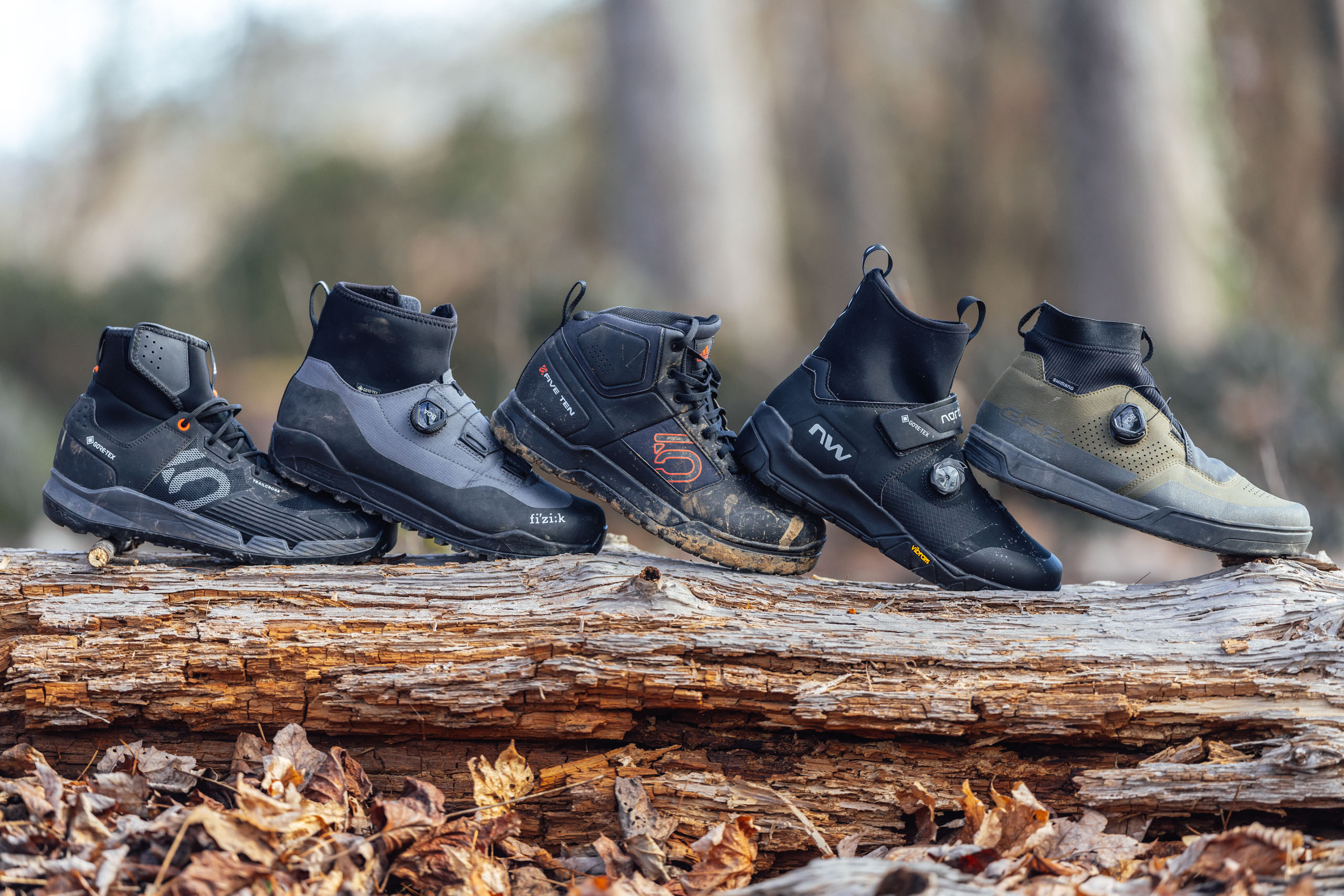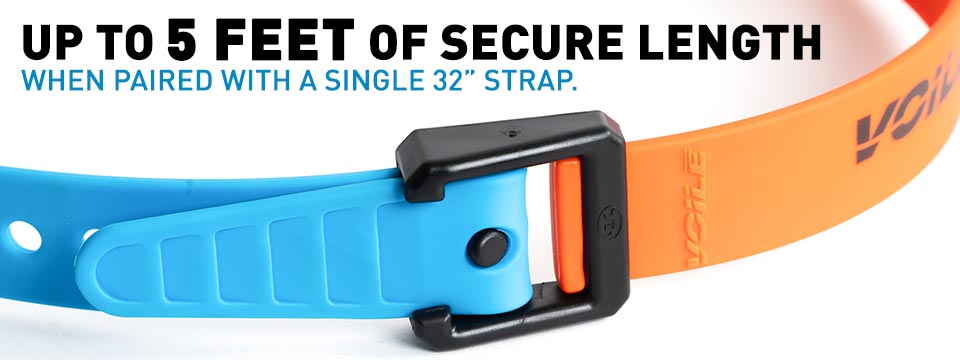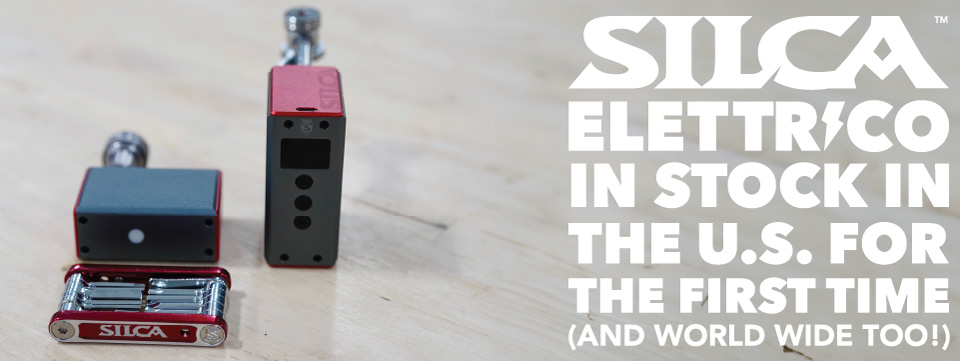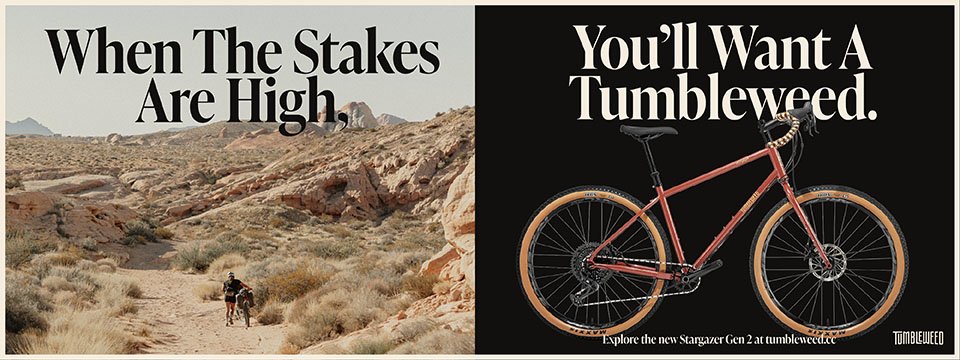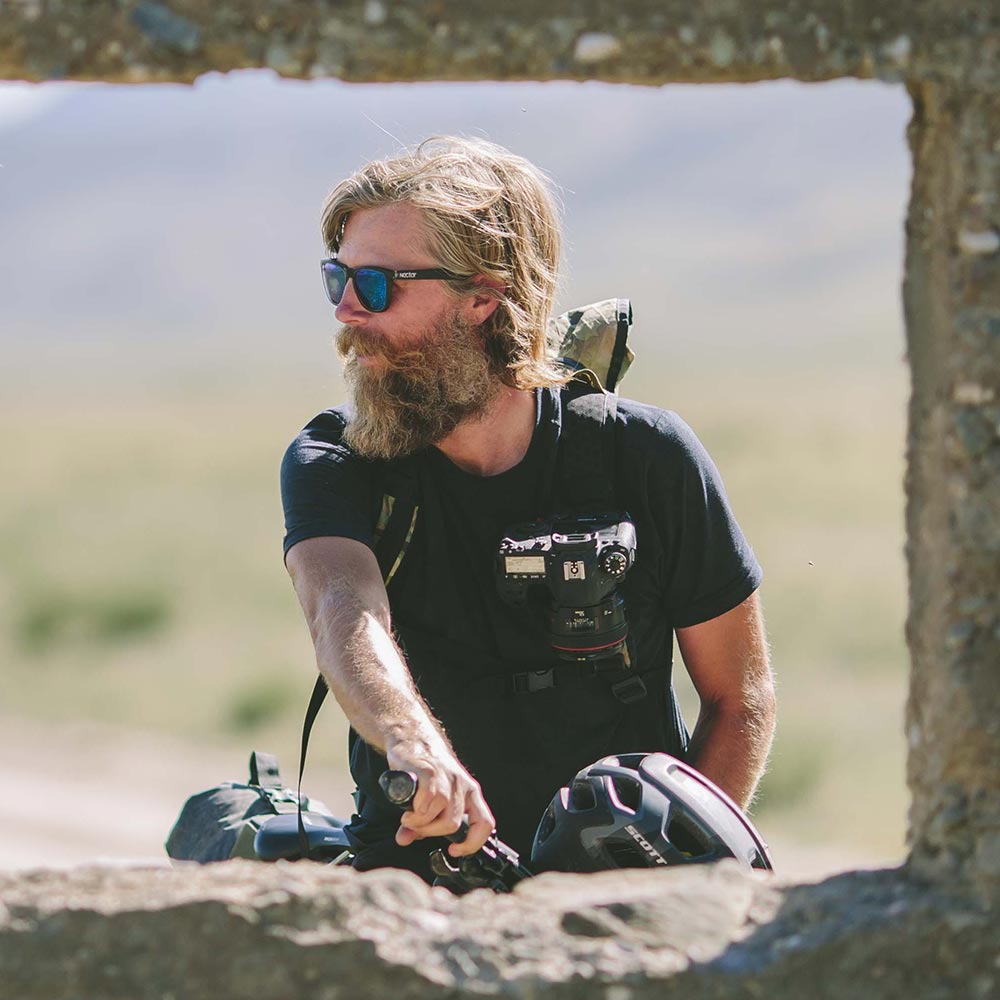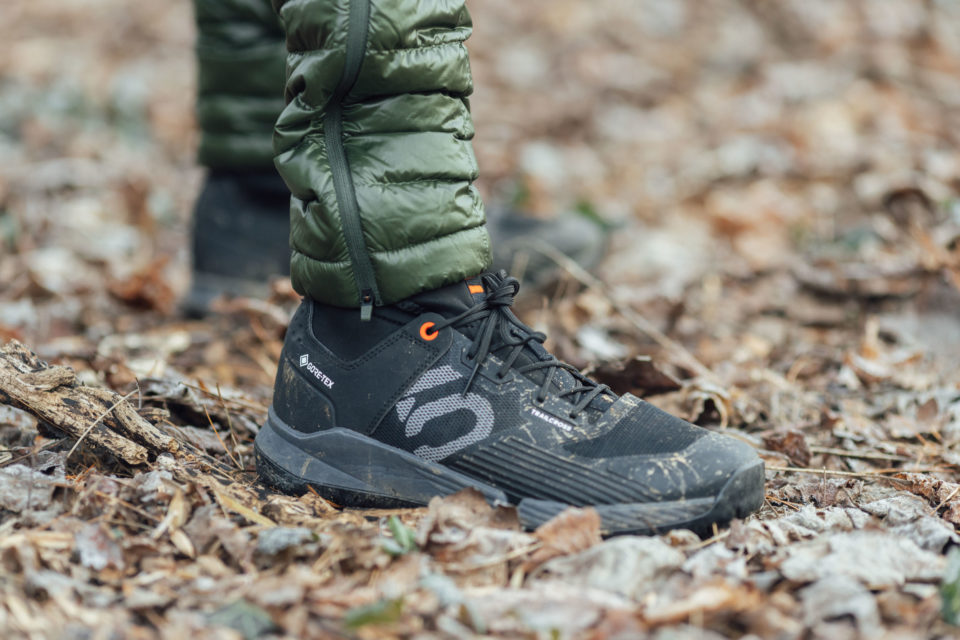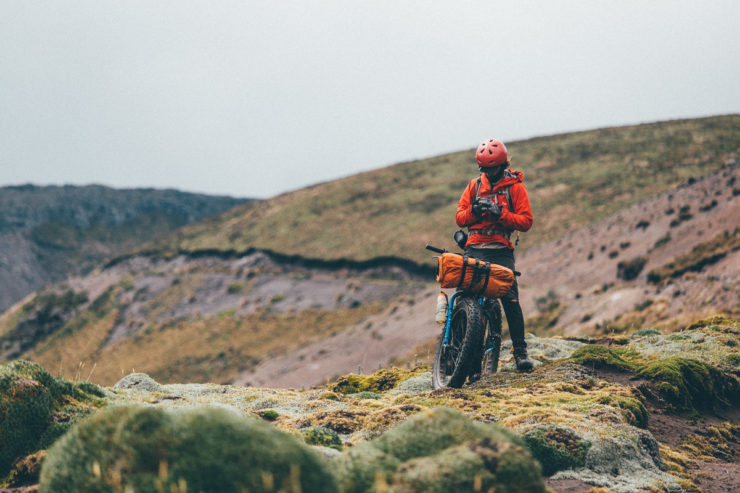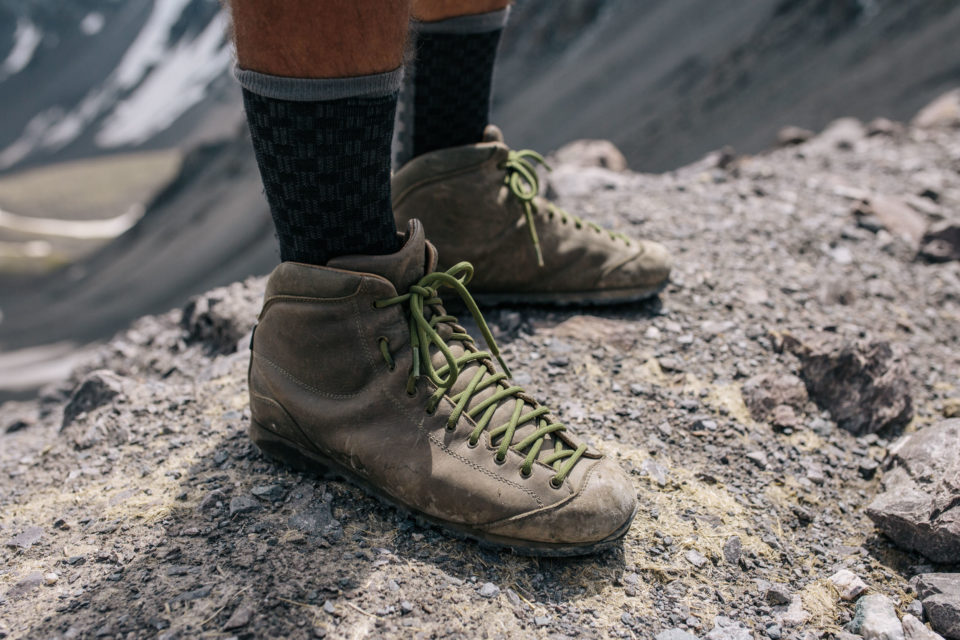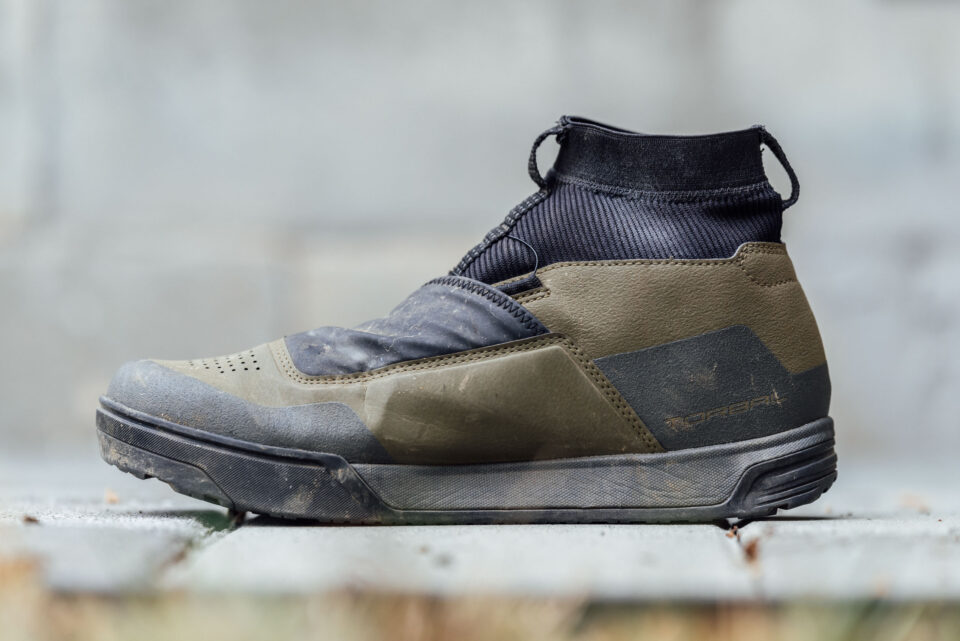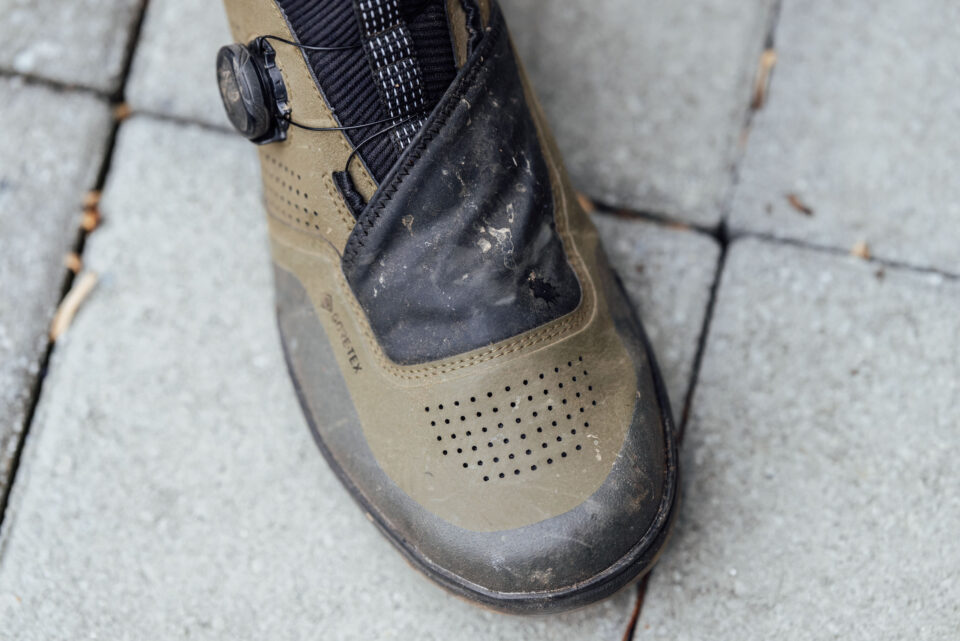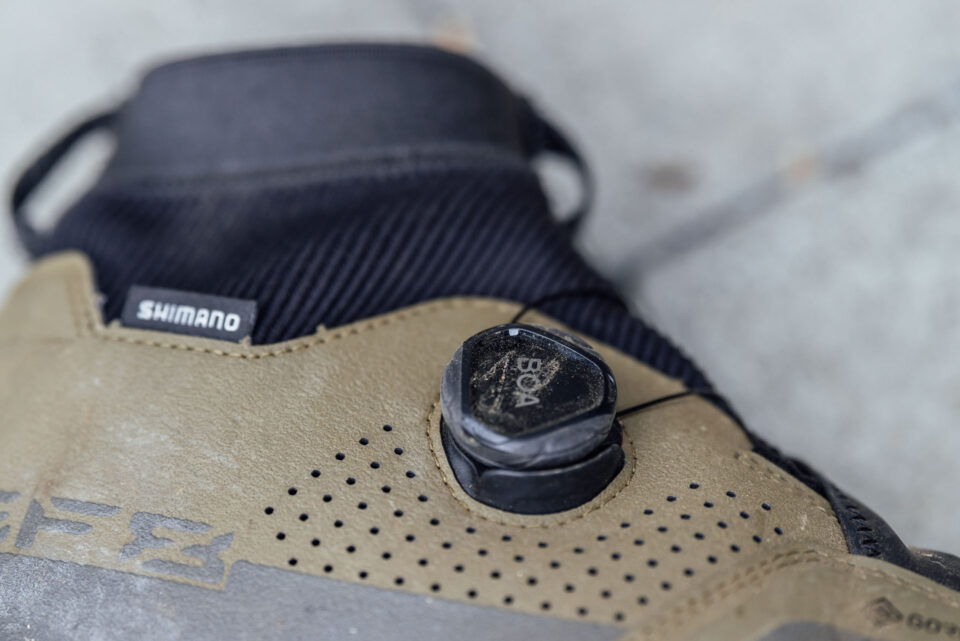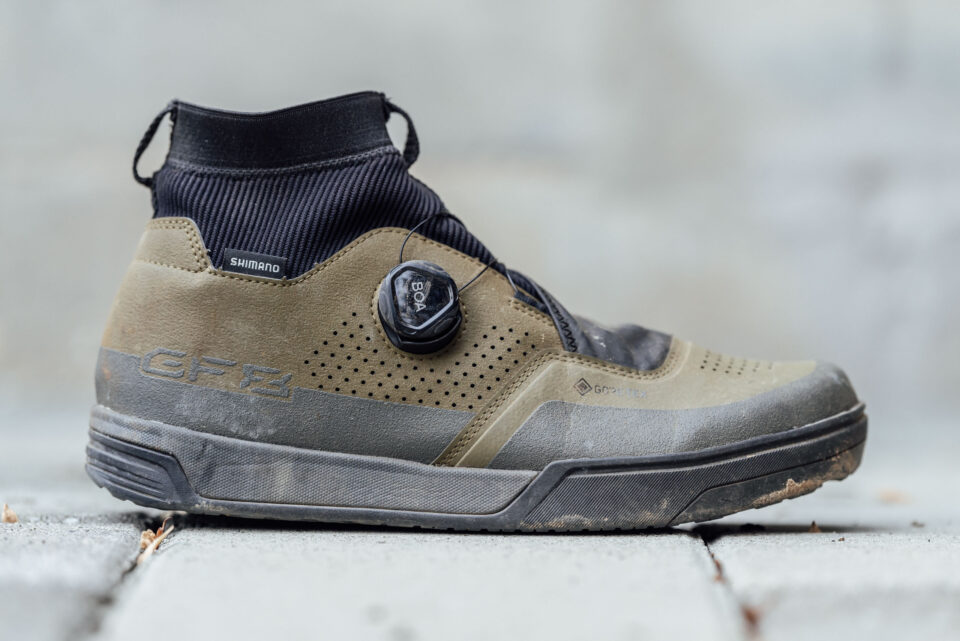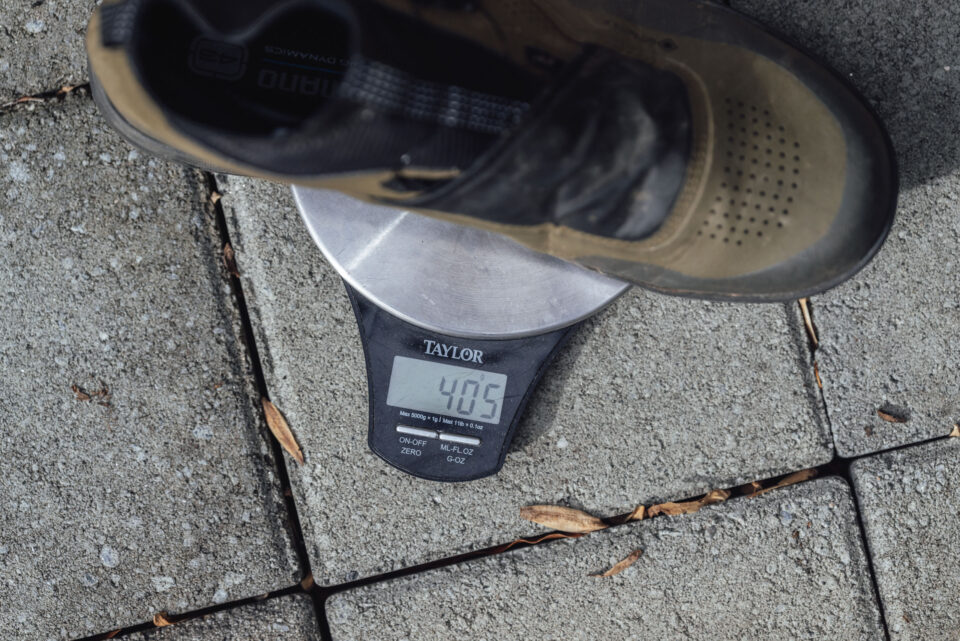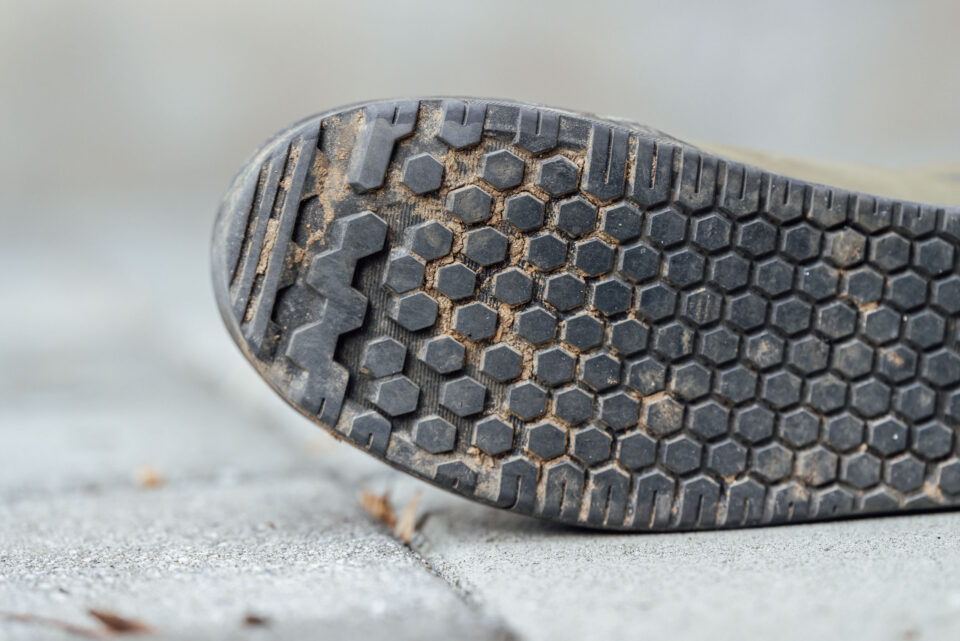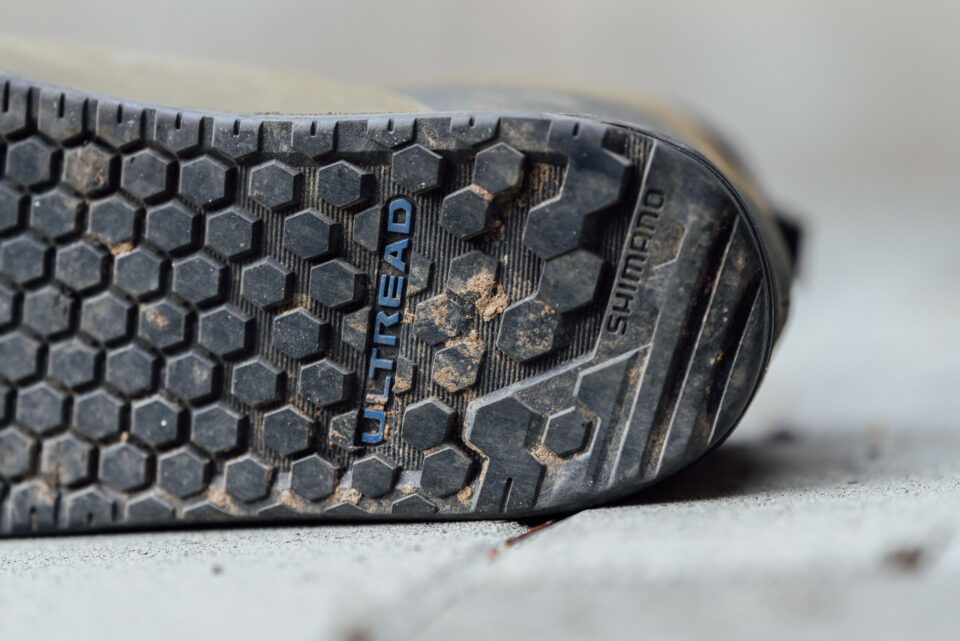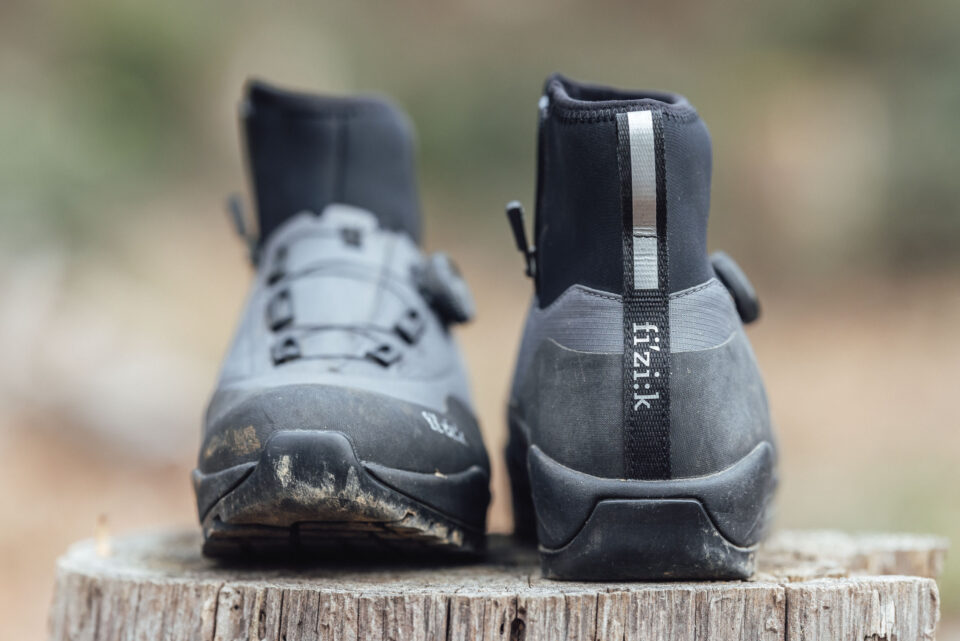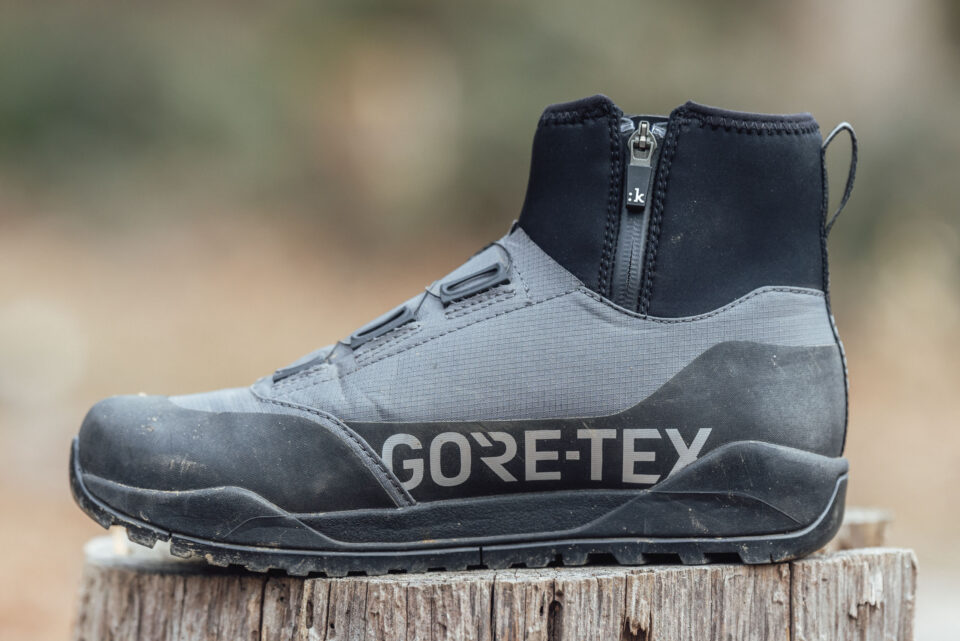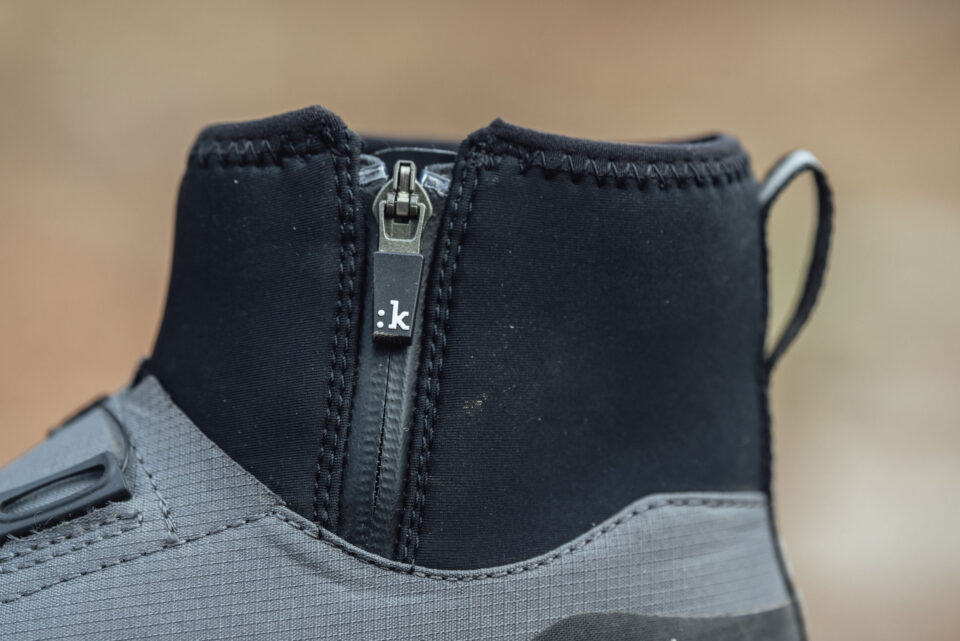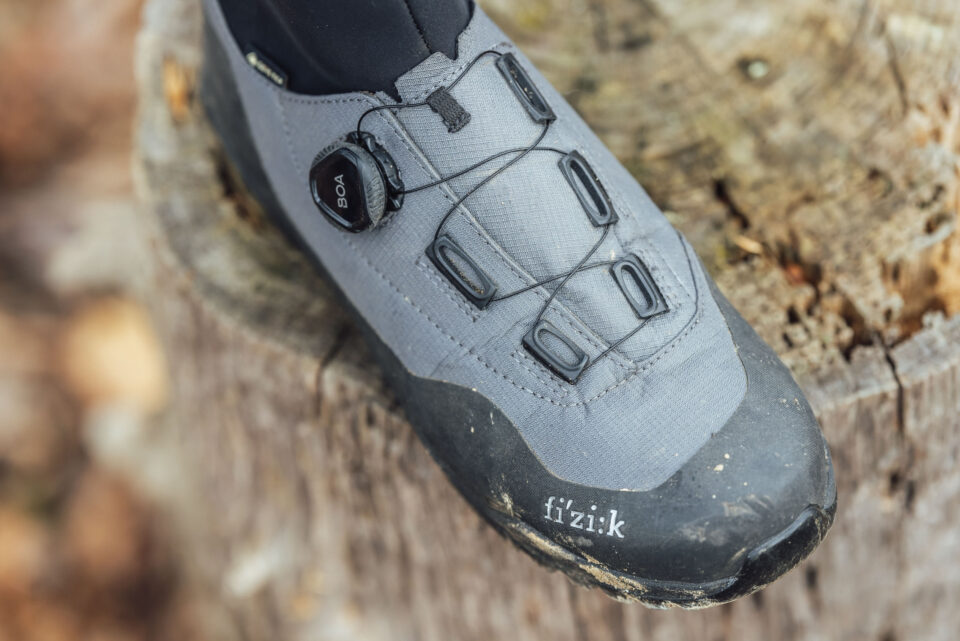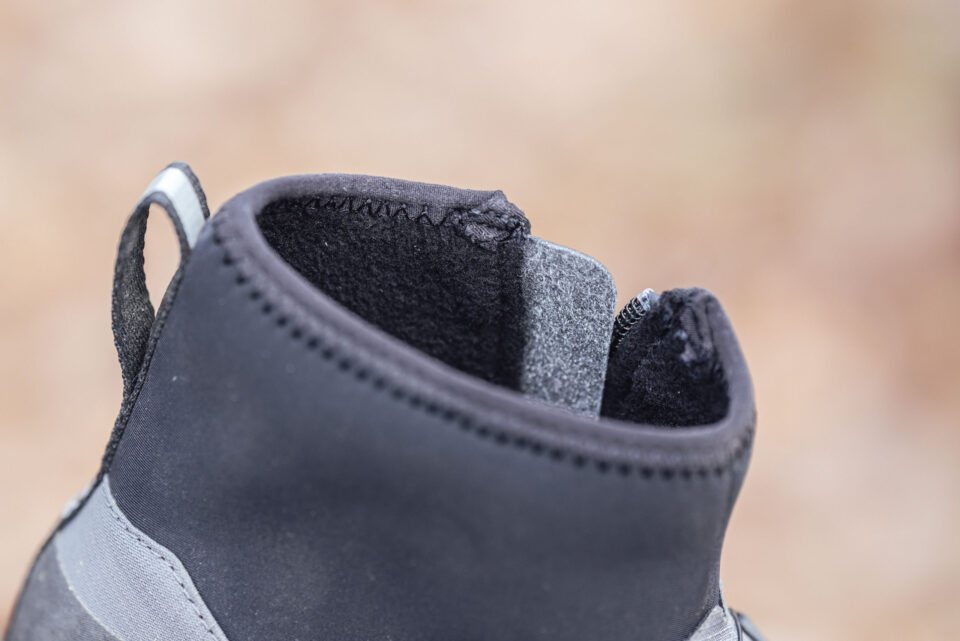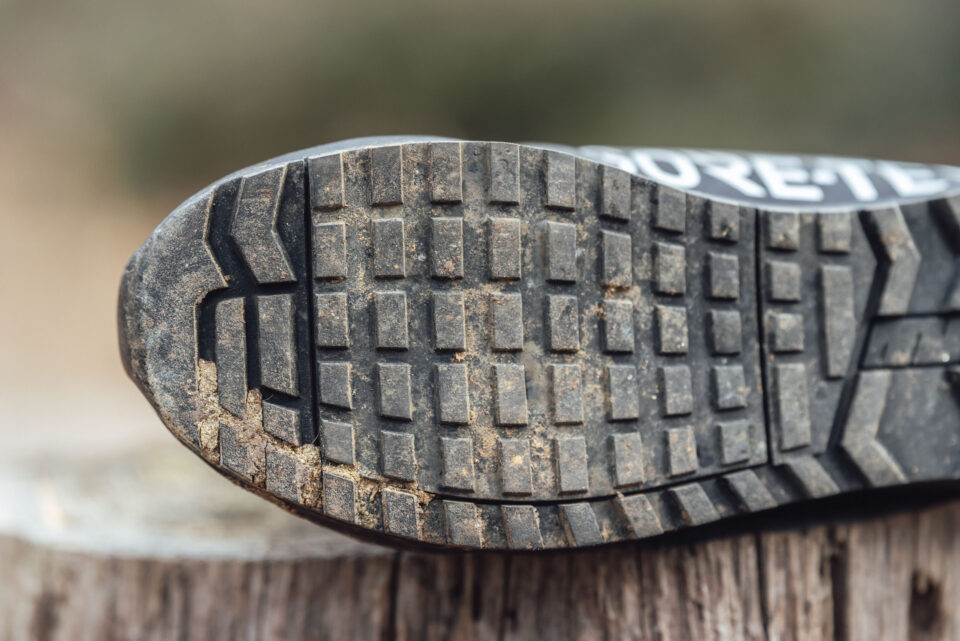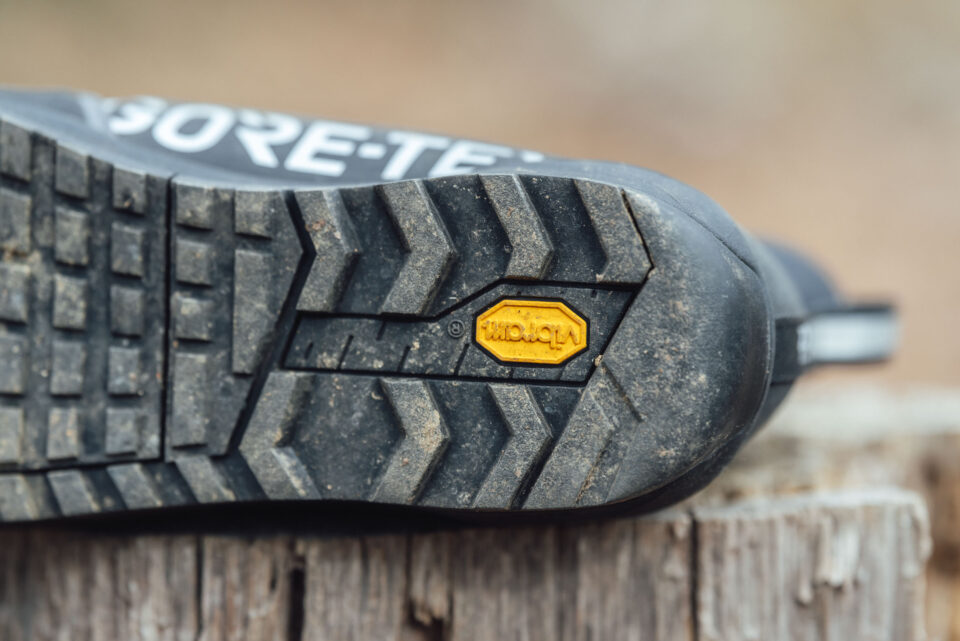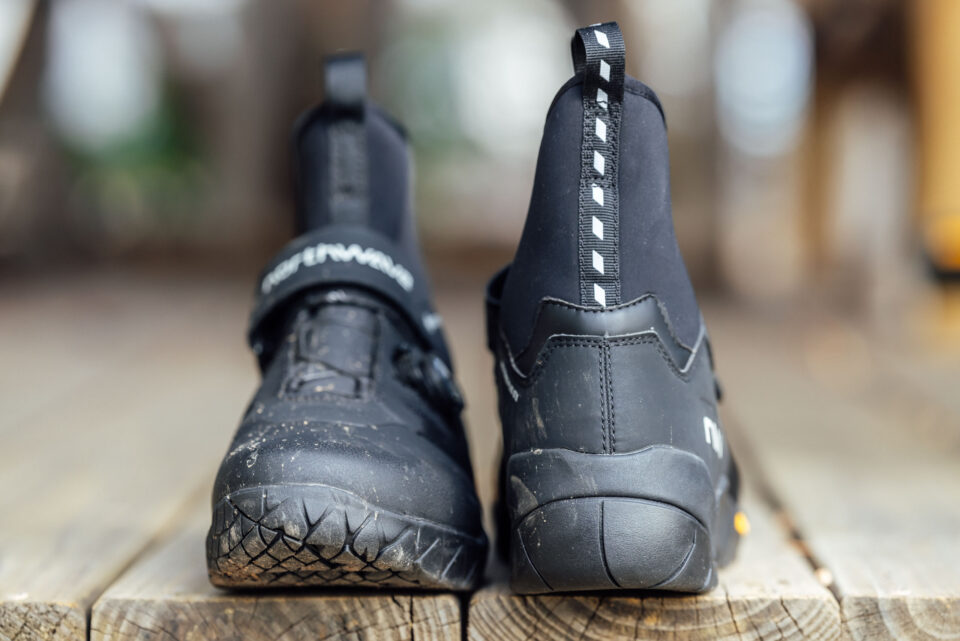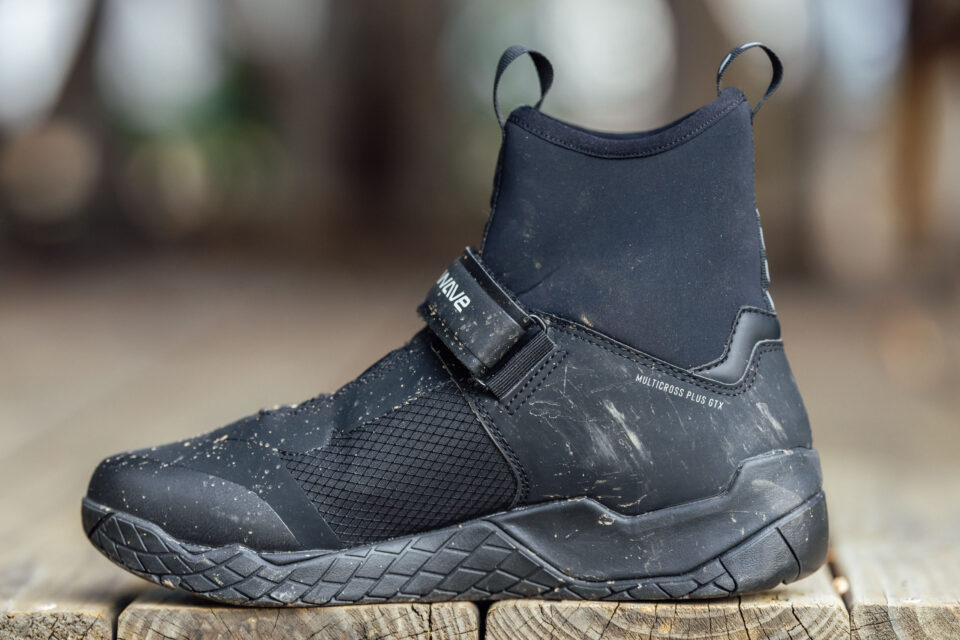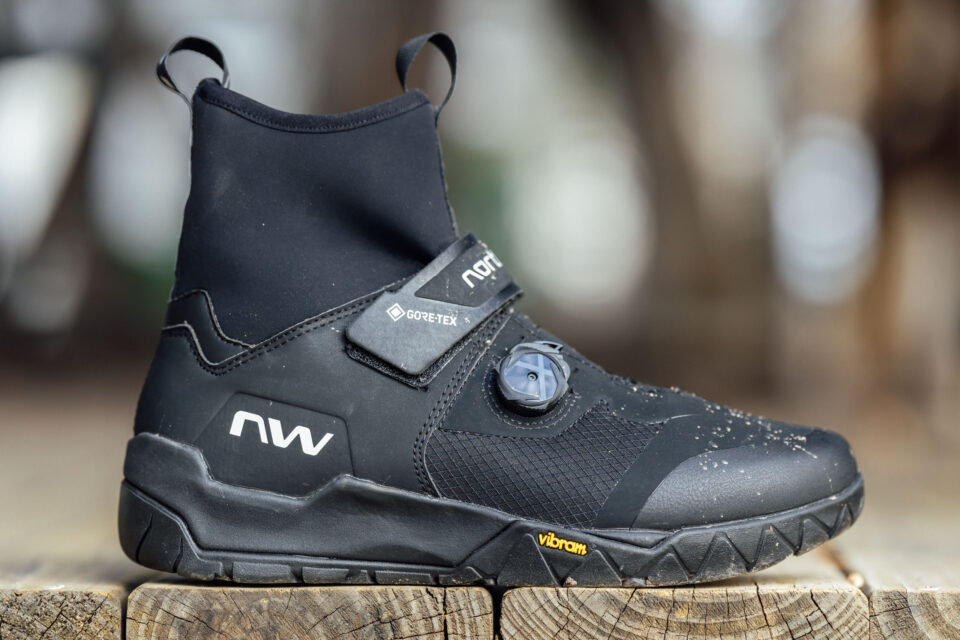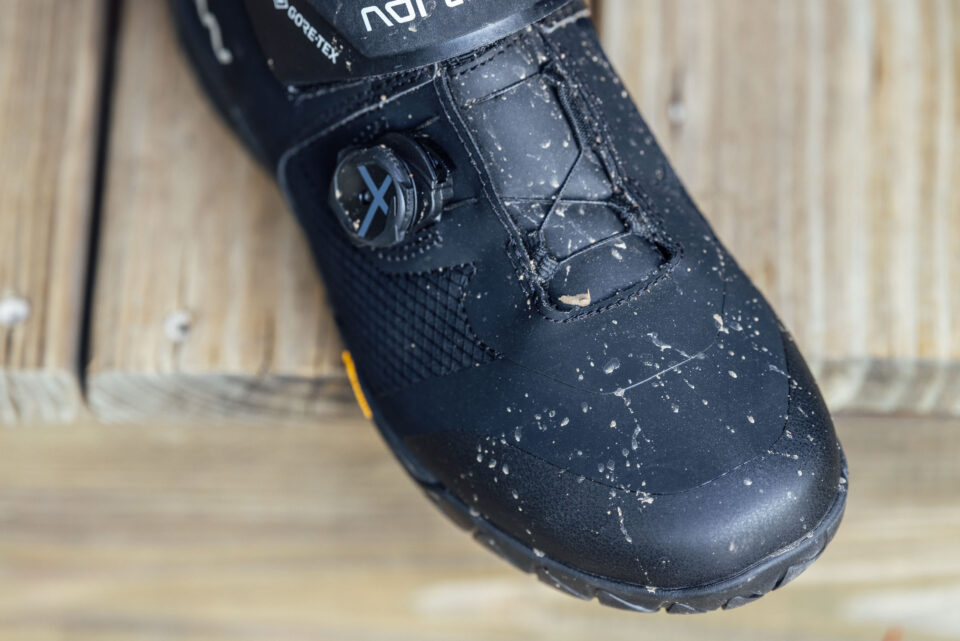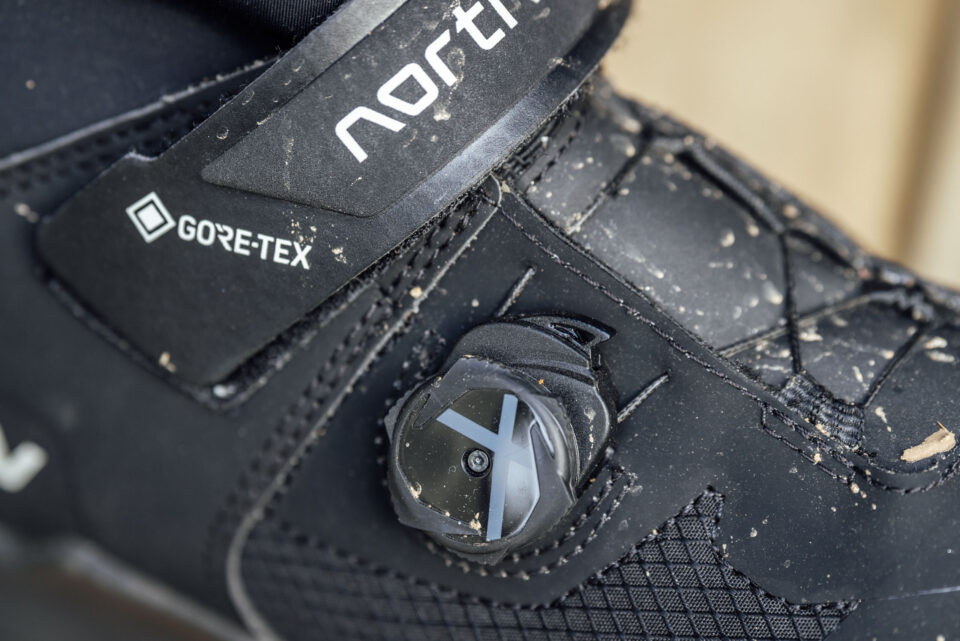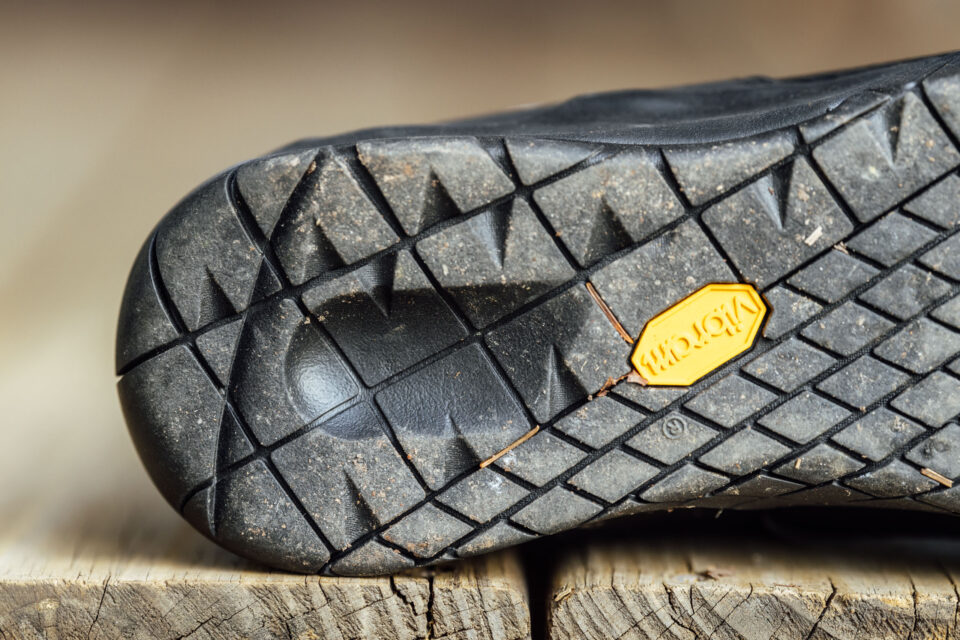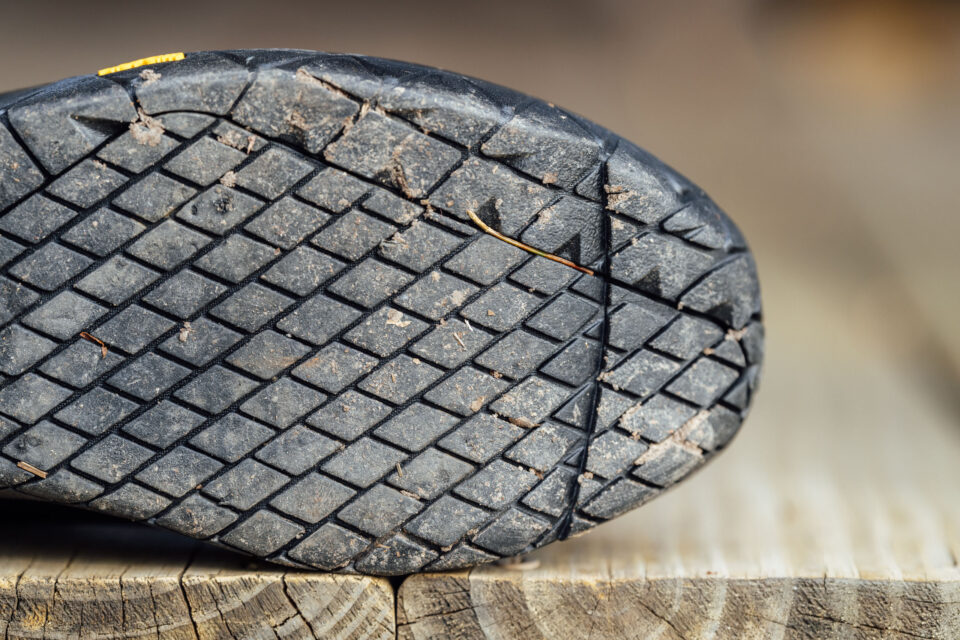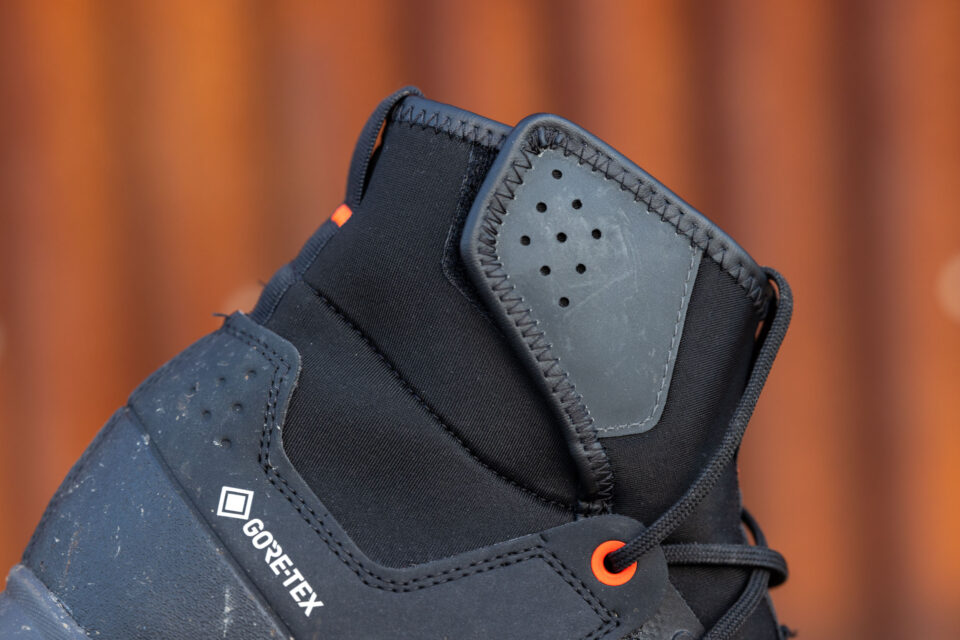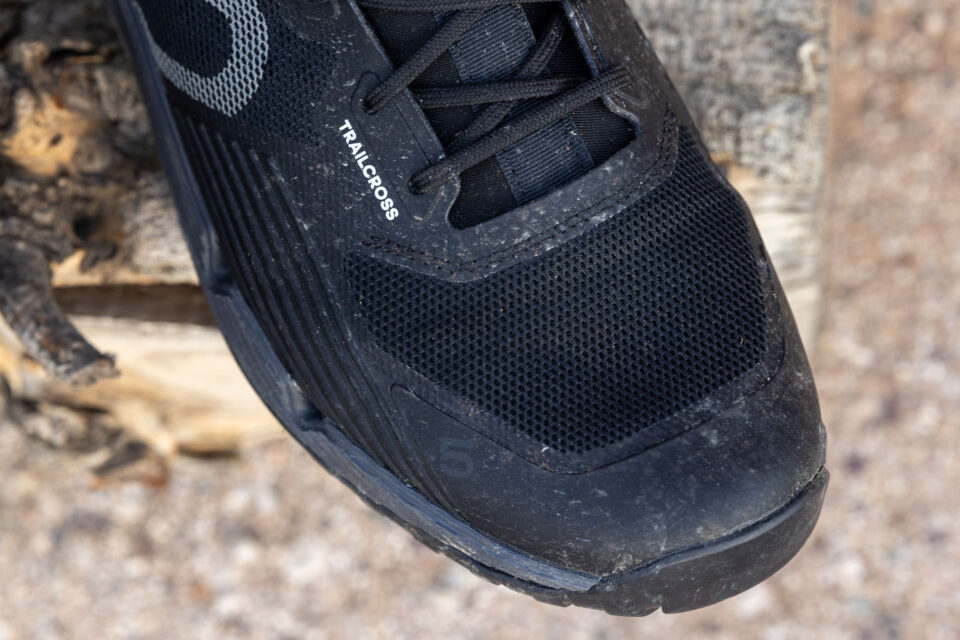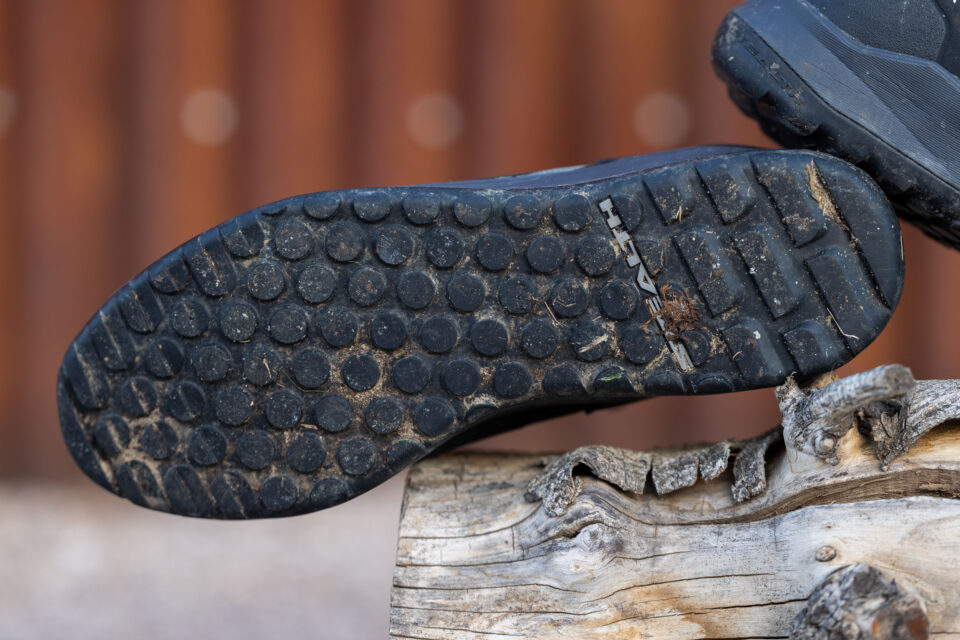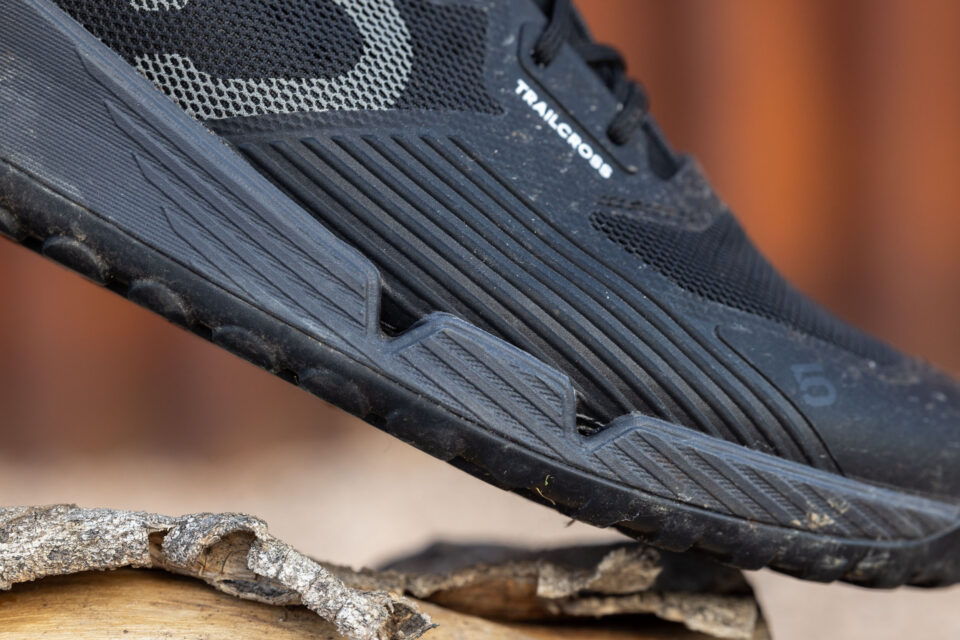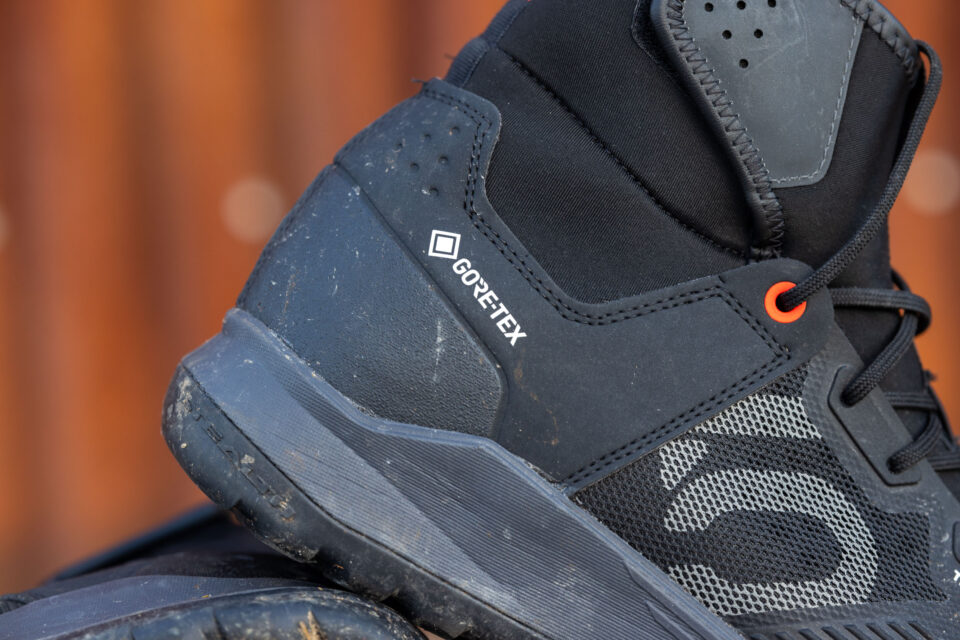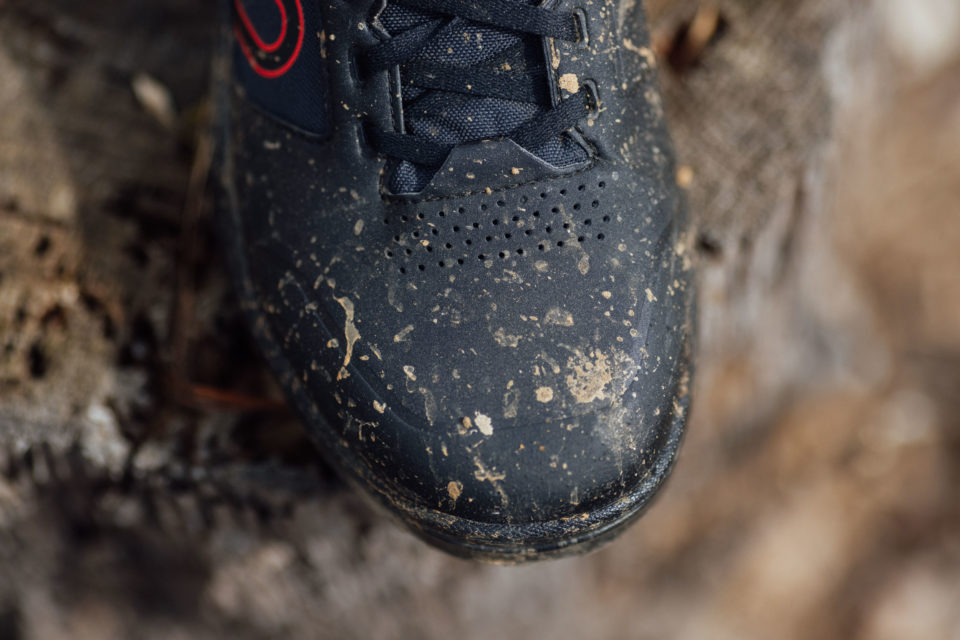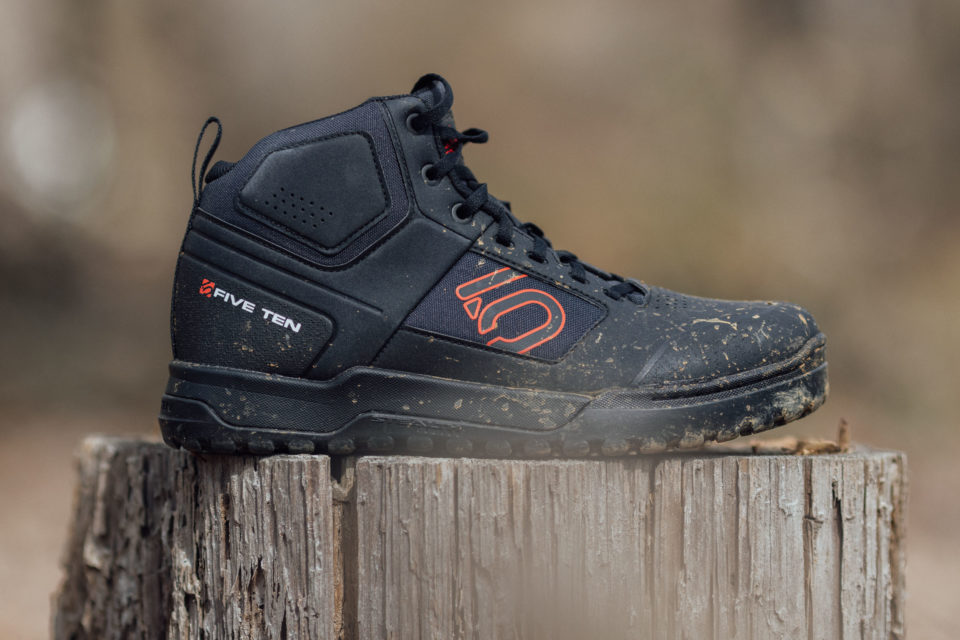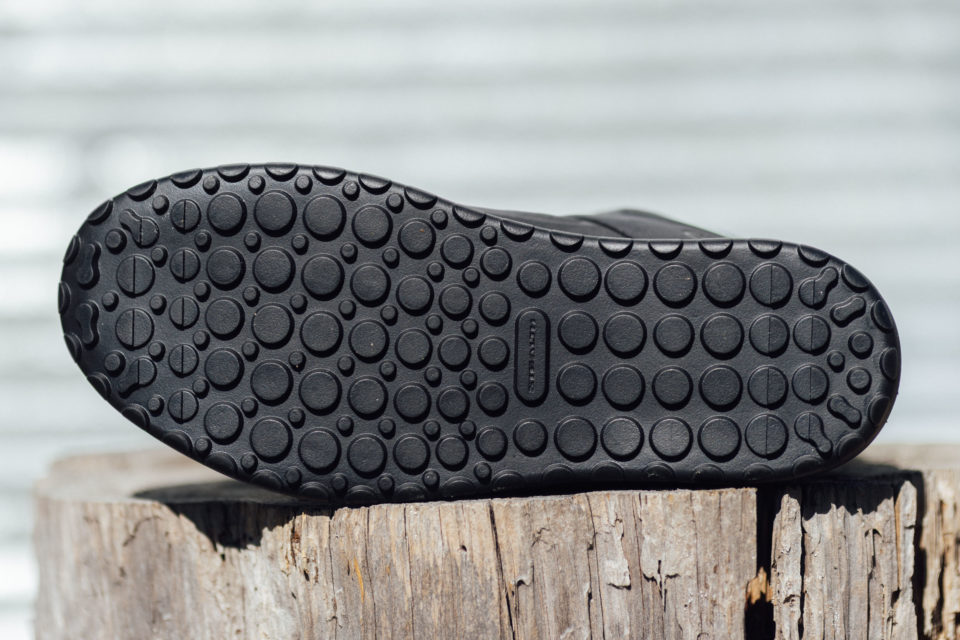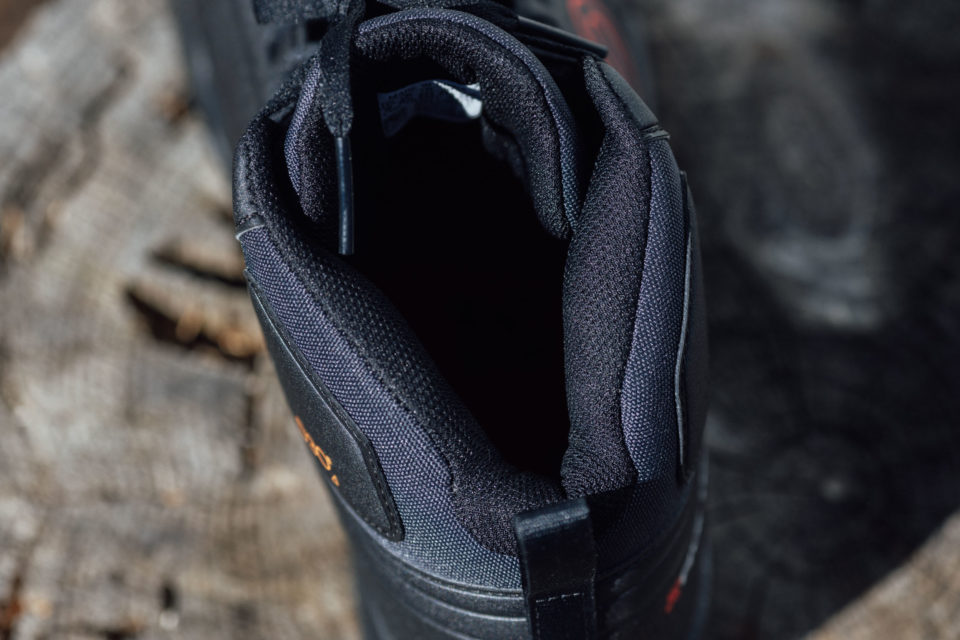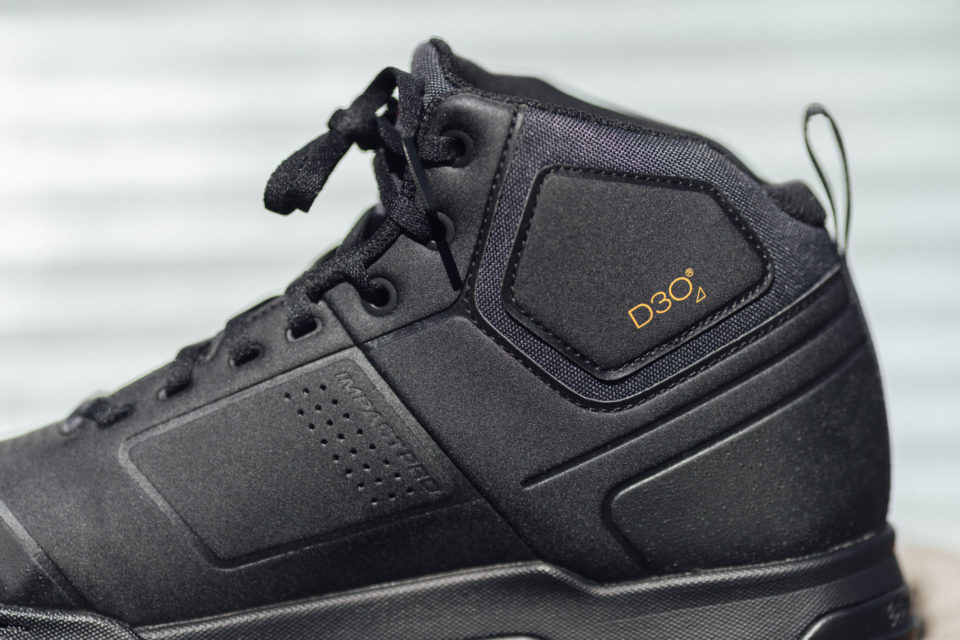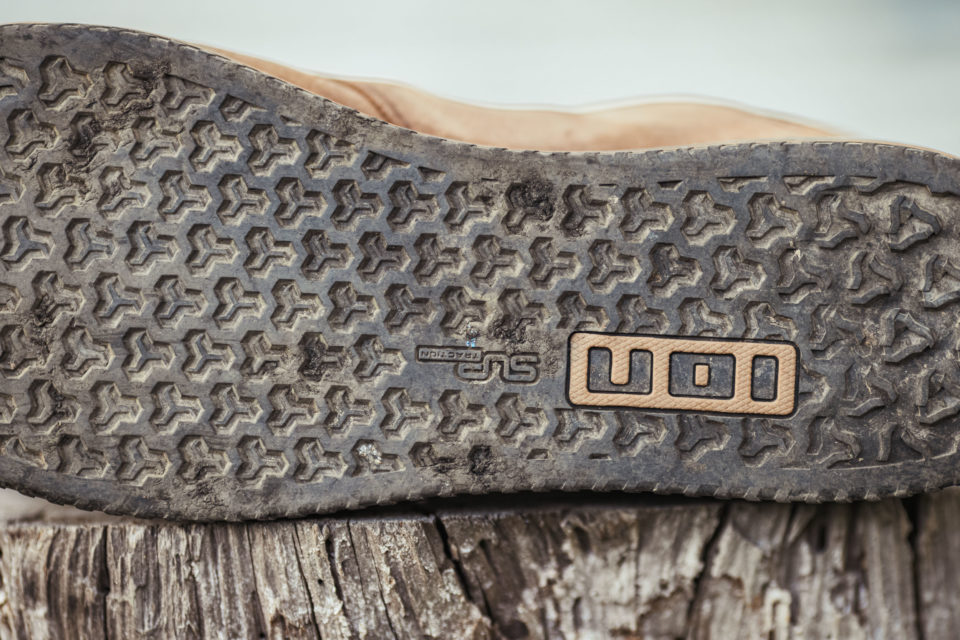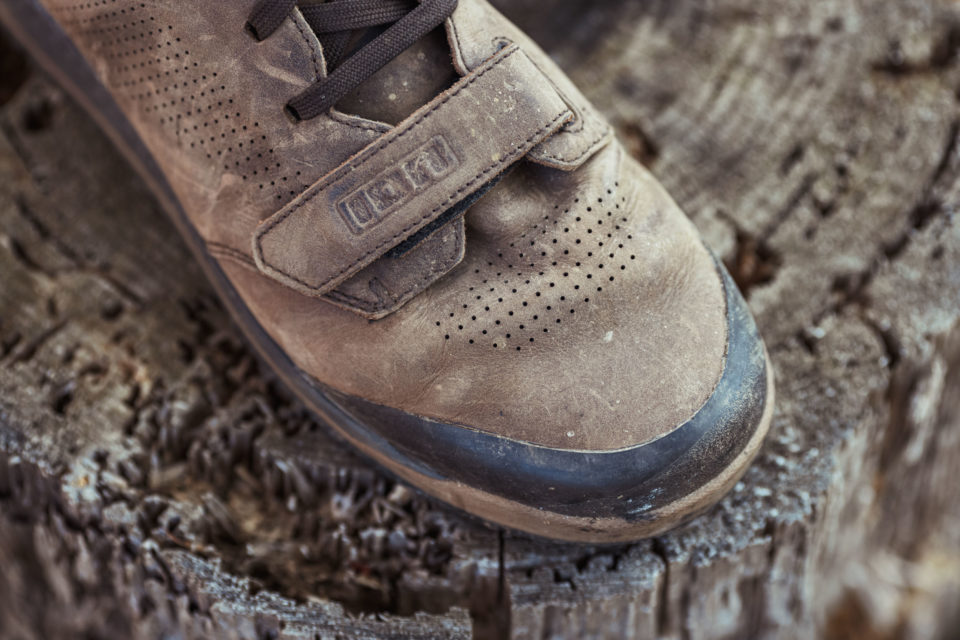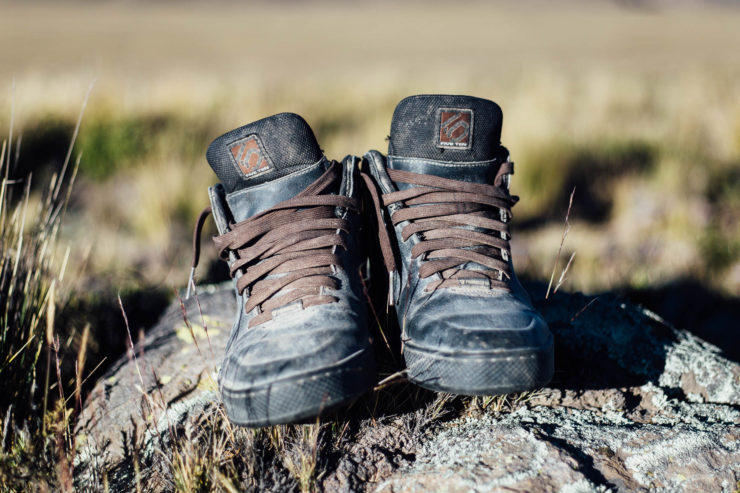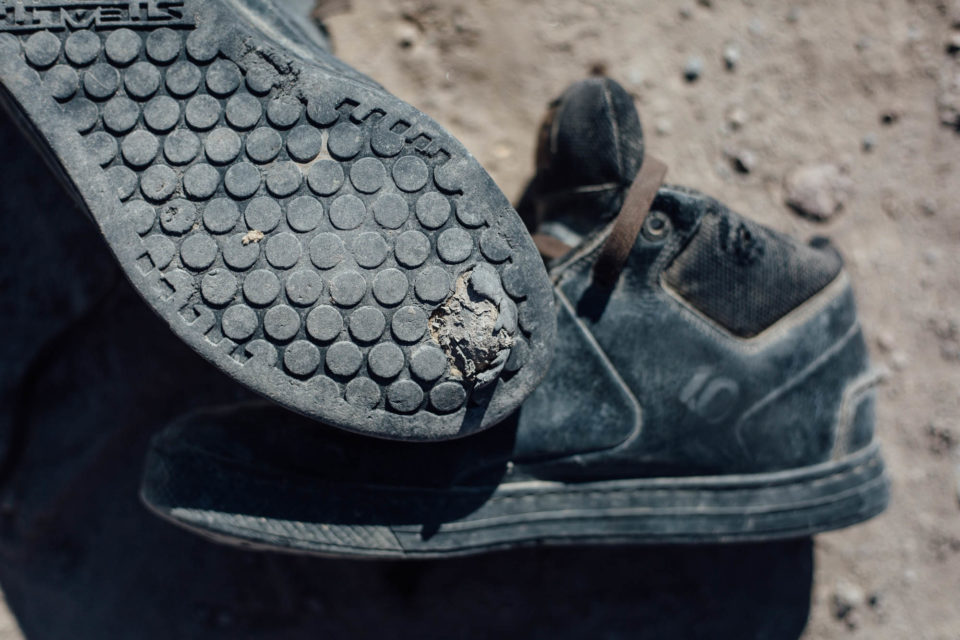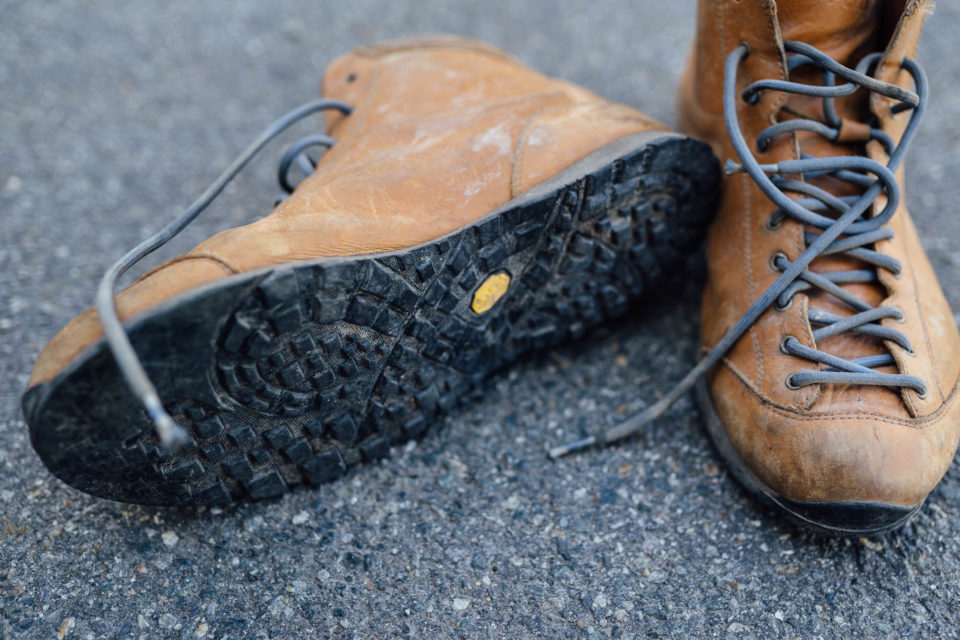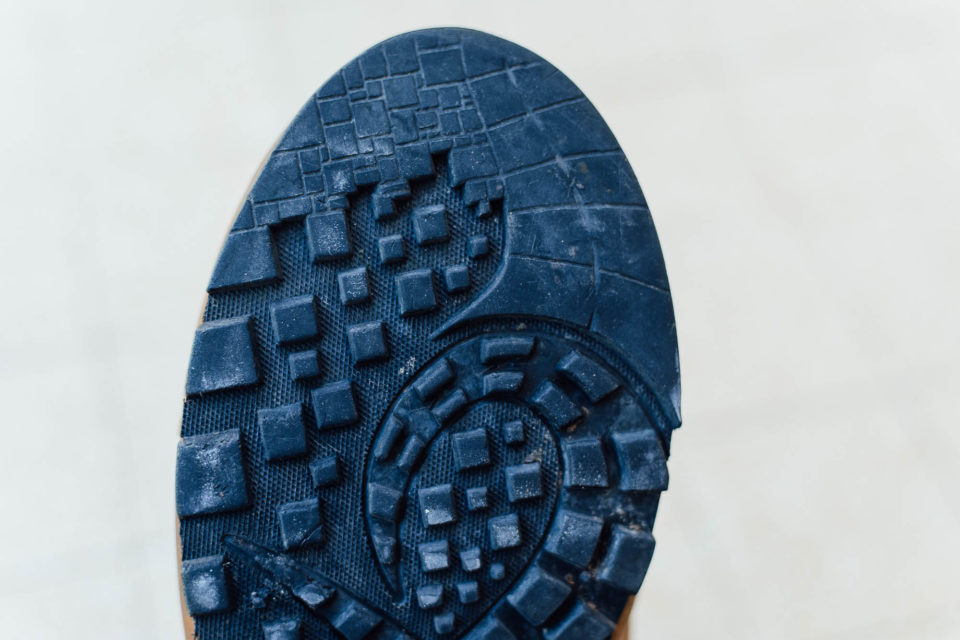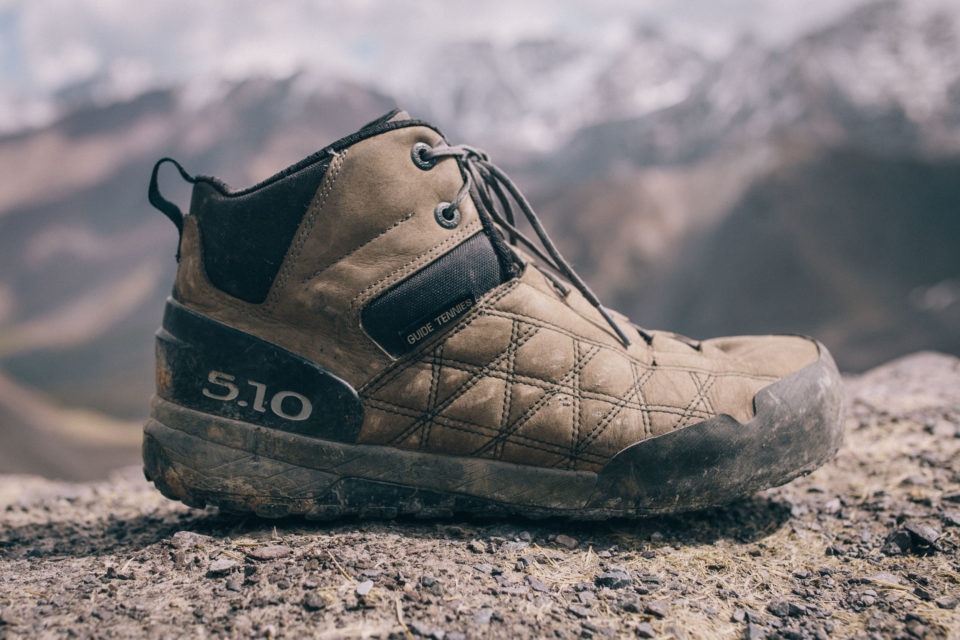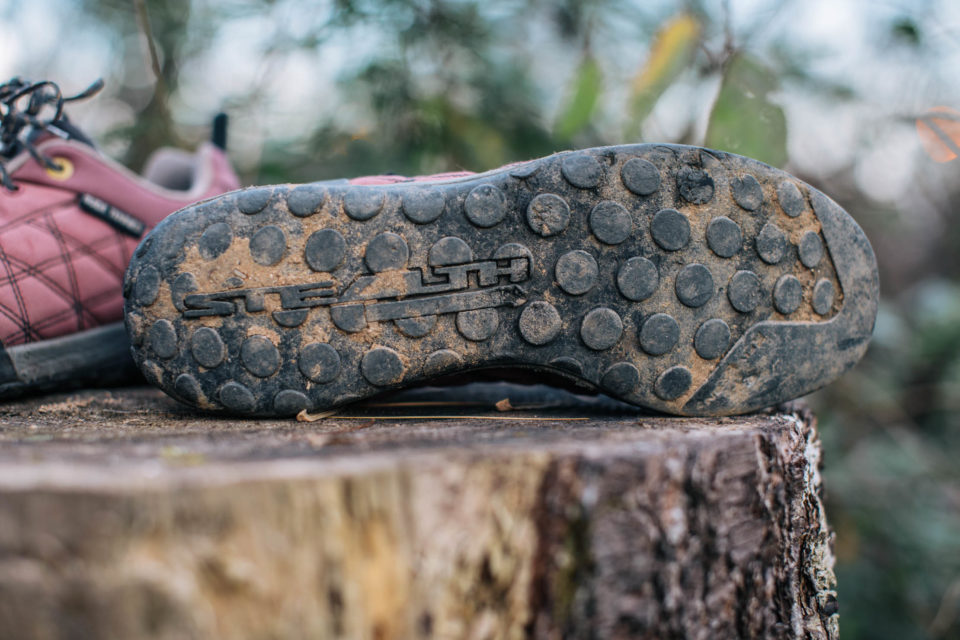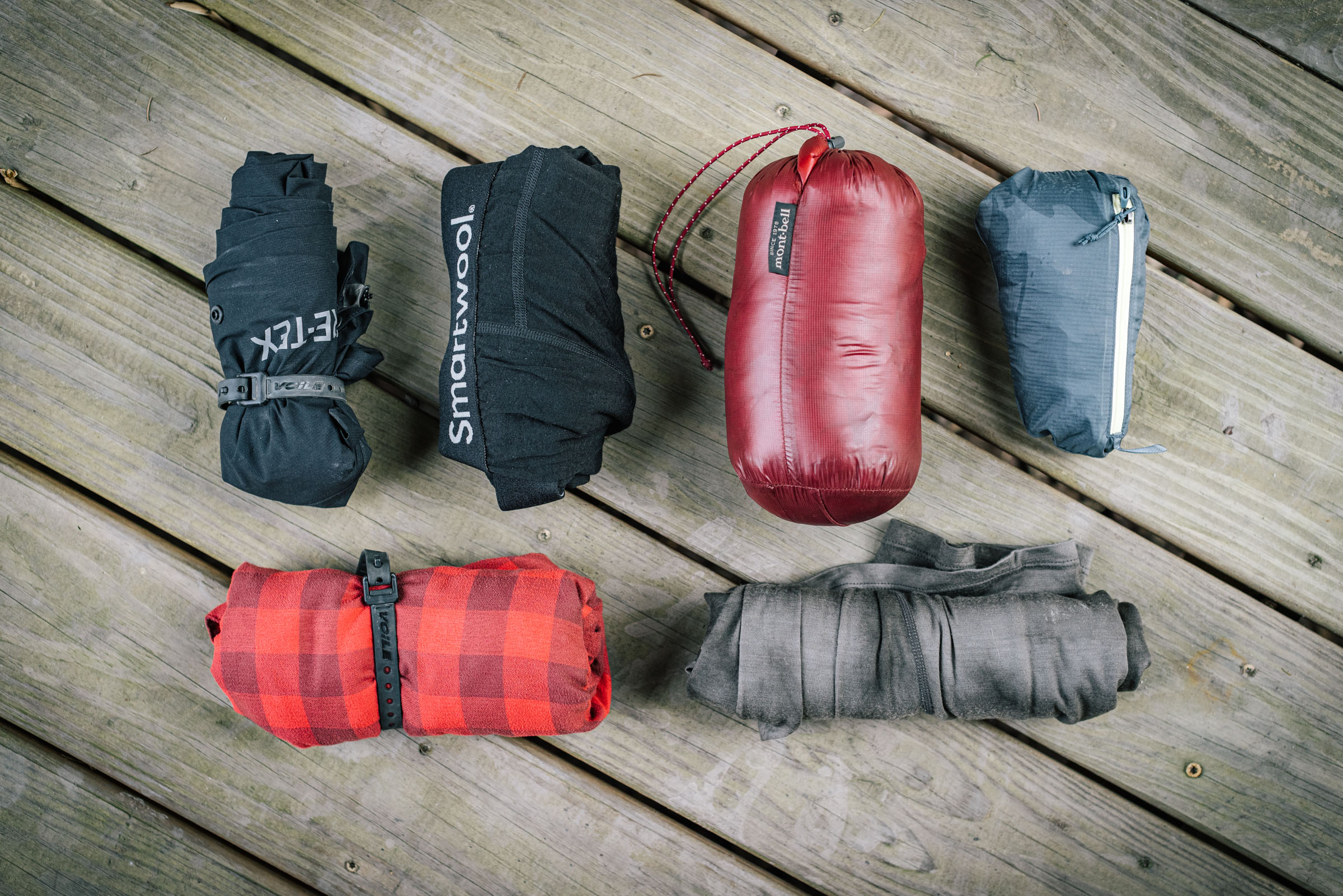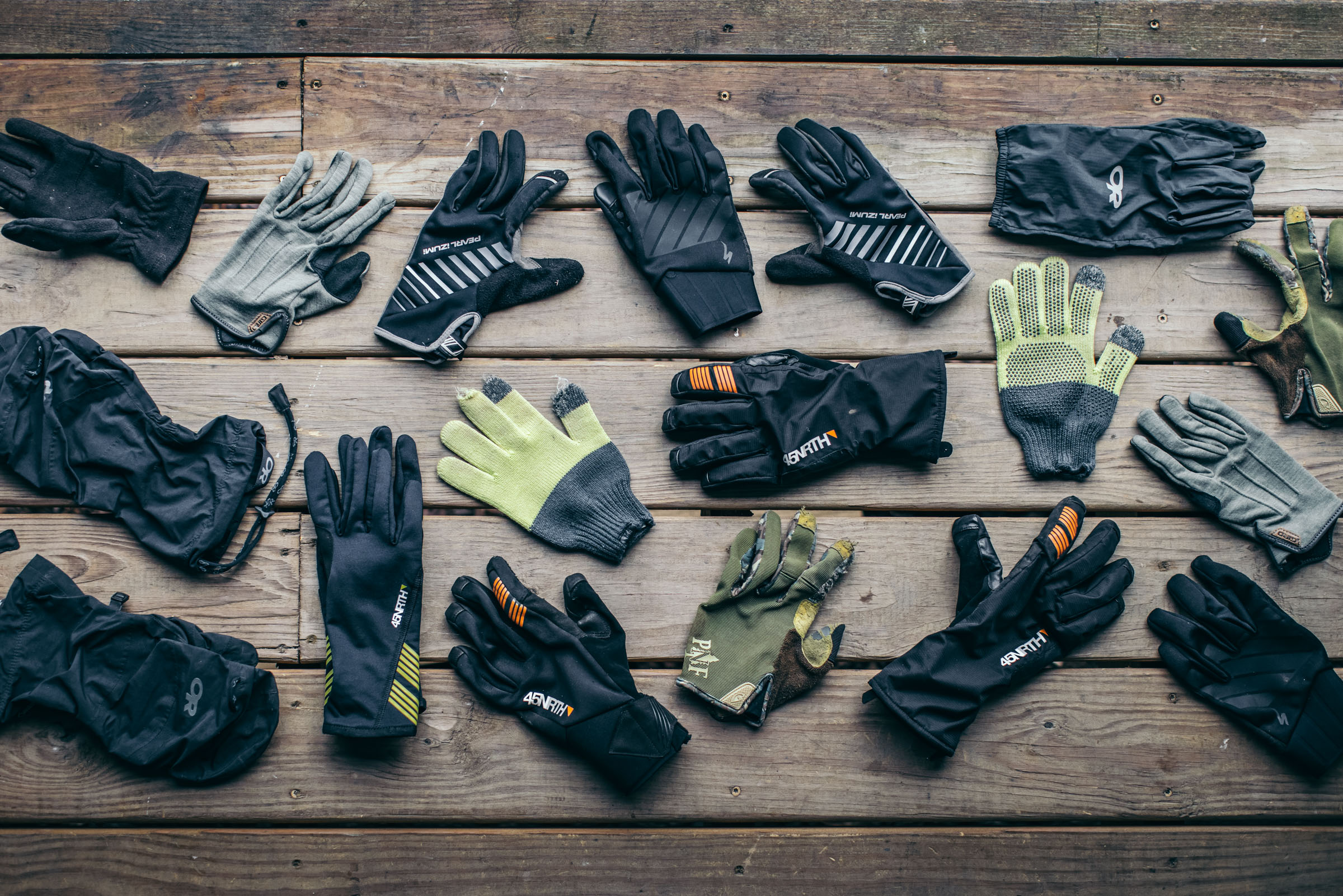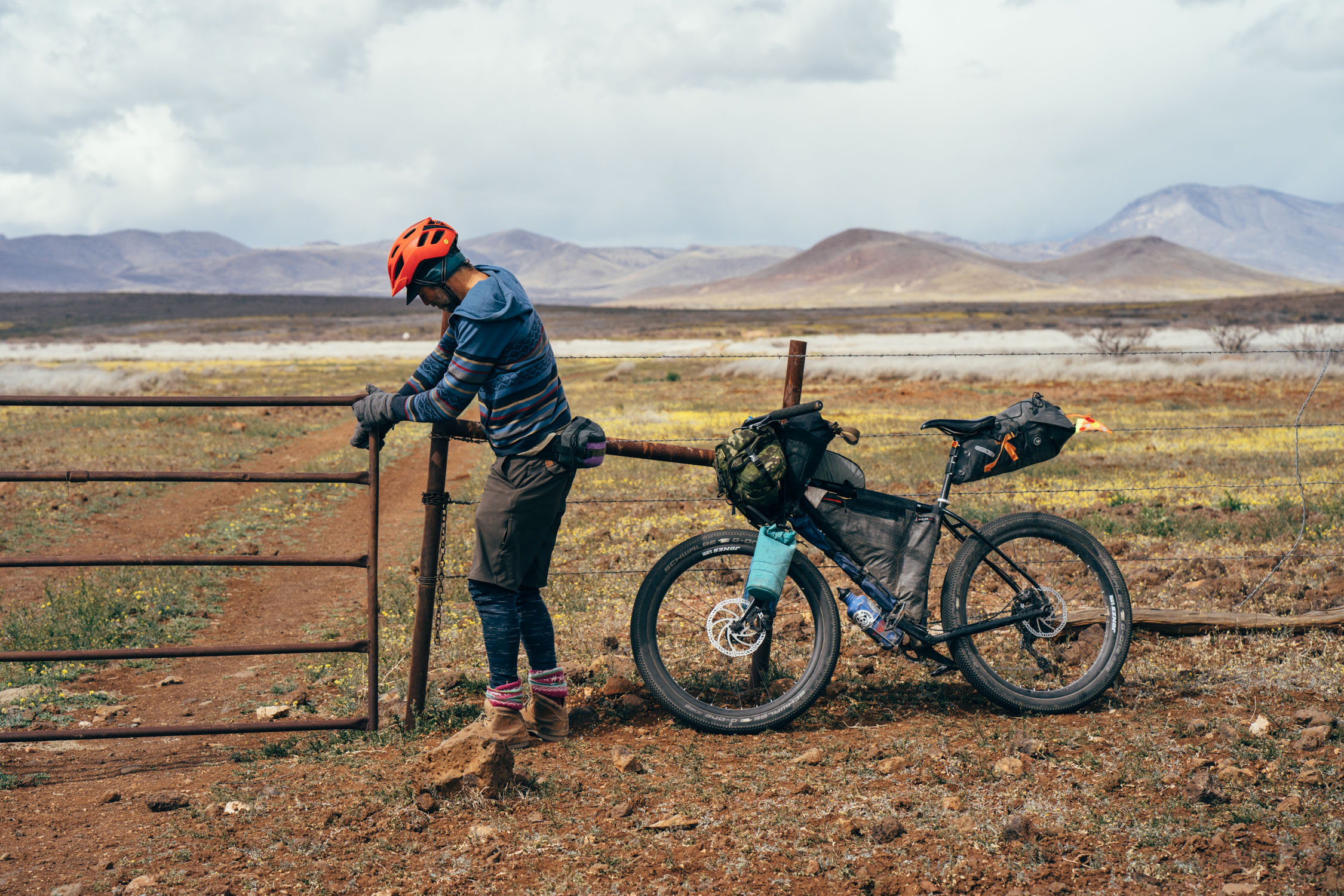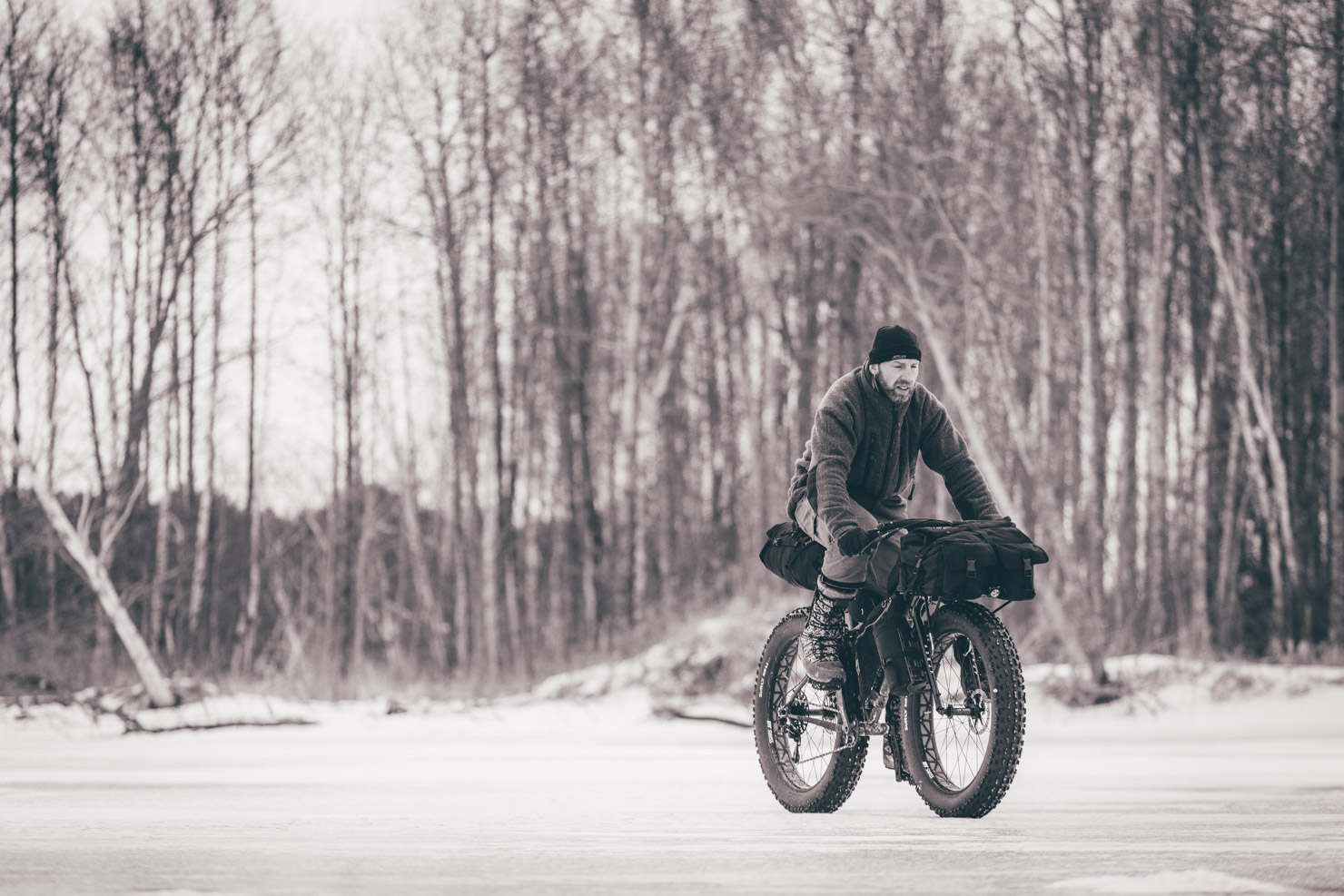Flat Pedal Shoes for Cold Weather
There seems to be a shortage of flat-pedal mountain bike shoes for cold weather—or mountain weather—and we’re always on the hunt for new options. Prone to cold feet, Logan has found several that work for him over the last few years, some of which might surprise you. Find the list here, plus a few tips for keeping your feet warm…
PUBLISHED Jan 17, 2024
This roundup was initially published in March, 2022, and was updated with several new reviews in January, 2024.
It seems like there aren’t many good options when it comes to flat pedal shoes for cold weather. I’m not talking about frigid temps such as the snowy environs best suited to burly fatbike boots. I’m talking about conditions that are on the edge of tolerable for non-winter people to get out and go trail riding or ATBing—temps just below freezing to 50°F (10°C)—or the variable temperatures and weather that comes hand-in-hand with backcountry riding at higher elevations.
Ultralight cycling shoes are nice and all, but the issue I have is that my feet easily get cold. Whether that’s due to poor circulation or having long, skinny legs, I don’t know, but even in 50°F temps, my toes can go numb without proper footwear. So, when it’s under 55°F, I usually reach for some heavier shoes. In addition, wearing a proper pair of rugged shoes is crucial in chilly conditions and mountain environments, as reinforced uppers, lugged tread, and padded ankle support all can act as insulation and help keep feet warm.
Contents (Shoe Reviews)
I actually had a touch of frostbite a couple of winters ago from repeatedly riding in sub-freezing temps. Part of the problem was not being able to find proper footwear. There seemed to be plenty of great cold-weather clipless shoes, but there just weren’t very many flat pedal options that fit the bill. I’m guessing some of you might recommend a few good hiking boots that could serve the purpose, but I have a couple of requirements that might change that. First, they can’t be too overbuilt and chunky. And second, they have to have fairly sticky rubber soles suited for more punchy and technical trail riding. Fortunately, we’ve found a few that tick both of those boxes—and keep your feet relatively warm—and wanted to share our findings in case anyone else is in the same boat. Here they are in a list ordered from the newest ones we’ve found to the oldest. Find mini-reviews, pros and cons, and relevant links for each below.
Shimano GF800 GTX (GF8GTX)
Made in China / 405 grams (per shoe, EU 43) / $220 at REI
Last year, Shimano unveiled an extensive lineup of new mountain bike shoes featuring both clipless and flat pedal options. The standout in this release to me—especially considering my cold-natured feet and the lack of insulated flat pedal shoes—was the GF800 GTX. Branded as the “Ultimate Cold Weather Flat Pedal Shoe,” Shimano was clearly trying to fill a void. I was able to pick up a pair in the late summer, and I’ve extensively tested them in various temperatures, ranging from pleasantly warm to unnervingly cold.
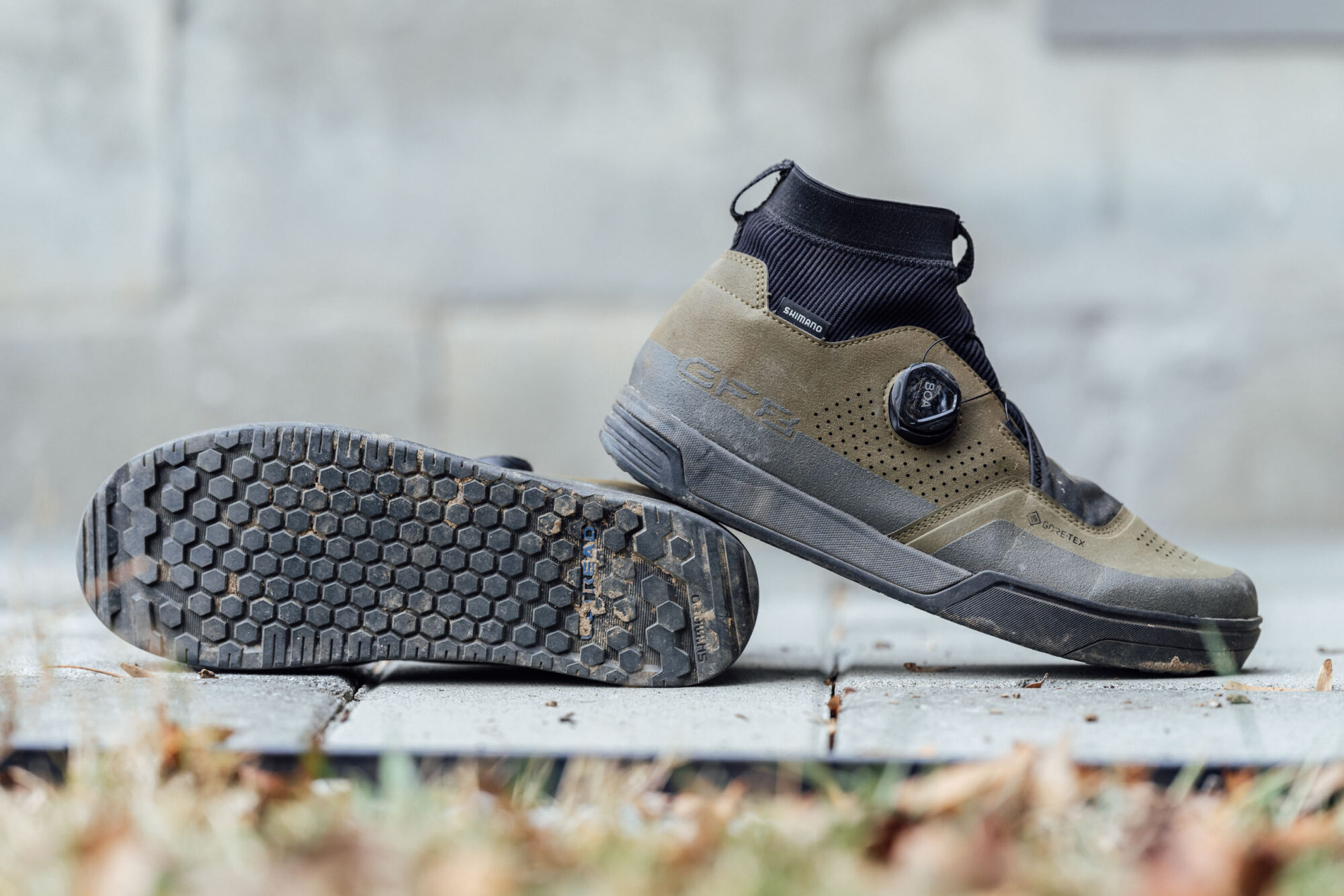
Shimano’s GF8GTX (or GF800 GTX, depending on who you ask) is a flat pedal trail mountain biking shoe through and through. What sets it apart from the slimmed-down GF6 is that it’s made for damp and chilly rides. It also has a slightly different variation of their ULTREAD rubber called GF rubber. Shimano claims that it’s strategically tailored for colder temperatures. I’ve used them in a variety of temps and find the GF rubber and hexagonal tread block pattern to be quite grippy, coming close to some of the better rubber soles I’ve tried, such as the Five Ten Freerider Pro. Similar to other shoes I’ve tested, they were’t super grippy at first, but they got better and better after a few rides. My one worry about the sole is that they’re fairly flexy compared to most of the other shoes listed here. I worry they might wear out quicker than others as a result, but only time will tell.
Out of the three most recent shoes I tested, including the Northwaves and the Fiziks, the GF8GTX seems the least like a winter boot and more like a mountain bike shoe. It was quite comfortable and undoubtedly felt like a high-top reinforced shoe and not a boot. Still, it has many of the trimmings of one, such as impact-protective rubber on the toe, sides, and heel, a heavy duty synthetic leather upper, an asymmetrically raised padded ankle collar, and an integrated sock-style upper. I didn’t test any of these shoes for their water resistance; but Shimano claims they have a full waterproof GORE-TEX liner. Still, the liner helped keep my feet warm down to around 45°F (7°C), although they started getting a little chilly around 40°F (4°C). I’d consider them as more of a shoulder season shoe than winter footwear, depending on your locale. They also seemed to breathe fairly well in reasonably warm temps.
Shimano claims the “TORBAL 2” midsole structure allows the heel section to move torsionally, maintaining full range of motion for better comfort and control. I would largely agree as I found these shoes to be quite comfortable and very accurate on the pedals, particularly during techy descents.
The GF8GTX use a single-dial BOA L6 Fit System closure, which works well and does a good job at evening out the pressure and didn’t create any hot spots for me. My one worry is that they use fabric loops for the cable. I’ve used shoes with similar systems but always worry that they’ll tear or wear out.
All in all, I was very impressed with the GF8GTXs. They’re not as heavy as other shoes listed here, and they’re quite comfortable and decently insulated as long as it’s not too cold. They also feel great on the pedals and offer excellent grip.
Fit and Sizing: The GF800 GTX comes in 11 sizes from 38-48 (5.5-12.5). I tested the size 43, and they fit like a glove. I’m pretty sensitive to having a wide toe box; I wouldn’t say the GF8’s is particularly wide, but I didn’t have any issues either.
Pros
- Super comfortable and undoubtedly feel like shoes and not boots
- Excellent pedal grip
- Multiple layers provide decent insulation
- Comfortable and secure fit
Cons
- Very flexy sole that I worry will wear out
- BOA dial does a good job, but cloth loops might wear out
- Good for walking/hiking but lose grip over slick surfaces and leaves
- Very few sizes
Fizik Nanuq GTX Flat
Made in China / 473 grams (per shoe, EU 42.5) / $279 at Fizik
Although we’ve reviewed several of Fizik’s cycling shoe models, this was my first experience with the brand’s line of footwear. The Fizik Terra Nanuq GTX Flats are clearly a premium pair of mountain bike boots, based on their specs, looks, and relatively high price tag. They feature a full GORE-TEX Koala membrane, which Fizik states is fully waterproof. And although Fizik’s choice for a product name is a little suspect—Nanuq is an Inuit word for young polar bear—I thought they were well worth a look for their waterproof features and claims of being fully insulated and breathable.
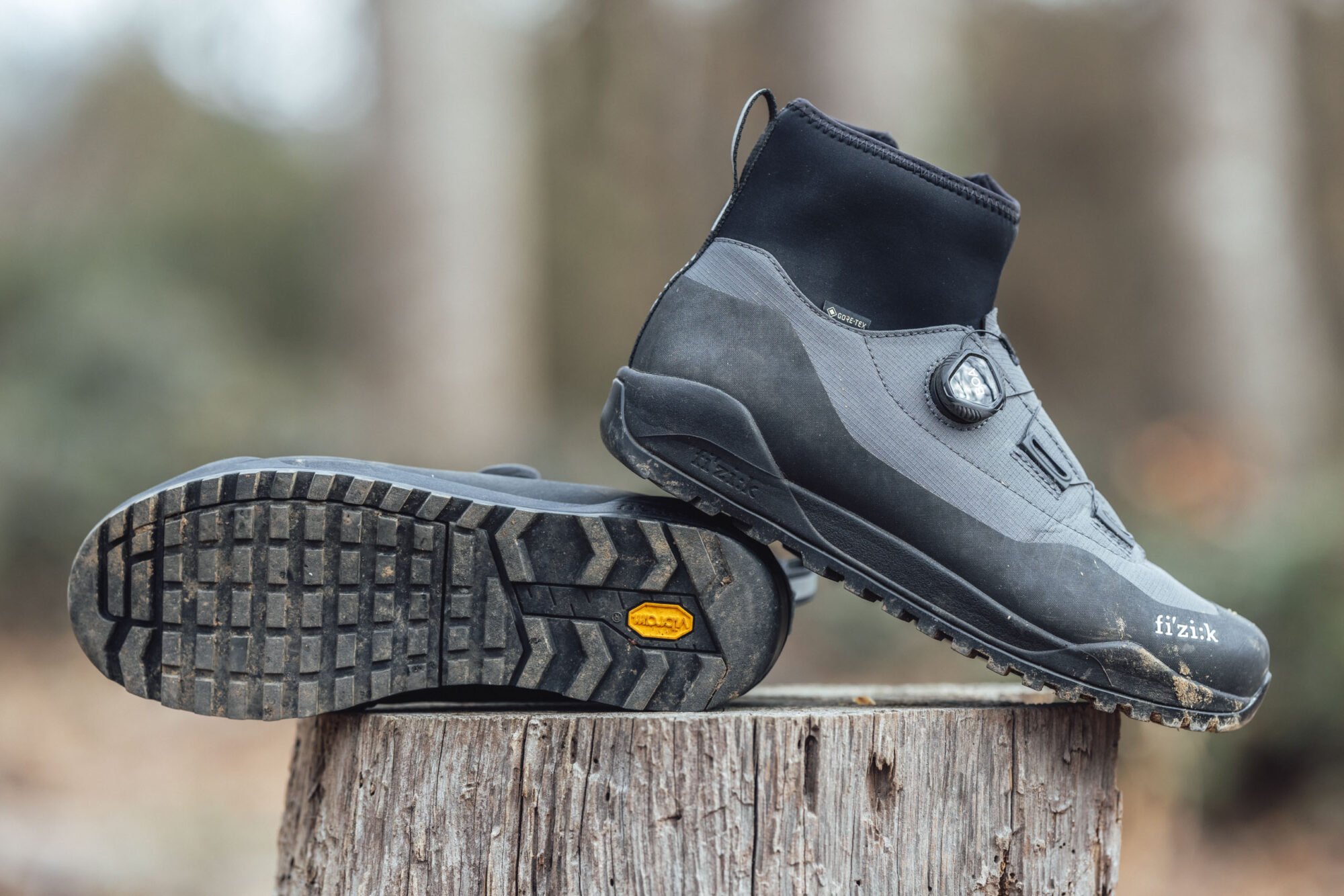
The Nanuq is made with a layered ripstop woven upper. It seems pretty tough, like Cordura, but I haven’t extensively tested their claims that it’s extremely resistant to abrasion and tearing. However, the shoe also has a thermo-laminated PU-reinforced toecap, heel, and lower sides for additional protection. They have a zippered cuff to keep out snow and mud and a BOA L6 dial serves as the only way to tighten and loosen them. All in all, they’re a pretty sharp-looking shoe, save the giant “GORE-TEX” lettering on inner side.
Right away, I was impressed with how comfortable the GTX Flats were. The BOA does a good job at applying even pressure, although I had to adjust them a couple of times mid-ride to get them just right. The insulated fleece lining immediately felt super cosy, and they fit very well. On the shoe-to-boot spectrum, I think they feel a little more like a boot when you first put them on. However, they don’t feel overly bulky or cumbersome on the pedals. They’re designed for off-road winter riding and feature a compressed EVA midsole for cushion and a Vibram rubber outsole with a rectangular waffle patterned tread.
On the first ride, I didn’t think the pedal grip was that great. While just pedaling along on flats and uphill climbs, I noticed that my feet floated around as the pedal pins moved within the tread. However, they seemed much grippier going downhill. On the second ride, I swapped pedals and noticed that they stuck to my Wolf Tooth Waveforms better than they did to the One Up composites. And after a few rides, they seemed to get more grippy, as if they just needed a little time to break in. They’re fairly stiff and sturdy feeling, but they also flex nicely at forefoot, which makes them relatively comfortable to walk in. And they have very good grip while hiking—perhaps better than many of the options listed here.
Looking at these shoes on the whole, the pedal grip was pretty good, but I was most impressed with the Nanuq’s insulation. I put five or six rides on these shoes in temps varying from 30-55°F (-1 to 13°C), and my feet only got cold at the tail end of a long ride at the bottom of that range. I suspect most people would be content in these shoes down to 25°F (-4°C), but for me, they’re a shoe I’d wear during rides down to just above freezing. On the high end of that range, my feet got a little sweaty, but not as much as I’d expect from a shoe this warm. If your priority is keeping your feet warm (and dry, I think) during the winter and colder shoulder season days, and you’re willing to make a top-tier investment for this purpose, the Nanuq GTX might be a solid choice. I’ll report back on their durability after a lot more use.
Fit and sizing: The Fizik Nanuq GTX Flat comes in 23 sizes from 36-48 with many half sizes. I typically wear a men’s 9.5/42.5 and tried the size 42.5, which fit very well.
Pros
- Super comfortable from day one
- BOA does a good job at applying even pressure
- Warm and fuzzy interior keeps feet warm down to just above freezing for me
- Fairly stiff, but they flex nicely at forefoot and are comfortable to walk in
- Decent pedal grip
Cons
- Zipper seems a little unnecessary
- Sharp-looking design, save the giant “GORE-TEX” type on side
- Good grip, but pins can float around in grid lugs on sole
Northwave Multicross Plus GTX
Made in Italy / 498 grams (per shoe, EU 42) / $297 at Northwave
The relatively new Northwave Multicross Plus GTX is an extension of the brand’s summer weather Multicross flat shoes. It has a shock-absorbing EVA midsole, TPU reinforcements in high-wear areas, and a dual closure that combines a large velcro strap with Northwave’s BOA-esque SLW3 dial. Similar to the Fizik above, the Multicross Plus GTX is built around a Koala Gore-Tex liner to offer breathability with water and wind resistance. This is perhaps the most “winter” of all the shoes listed here, and it’s also one of the most burly and heavy.
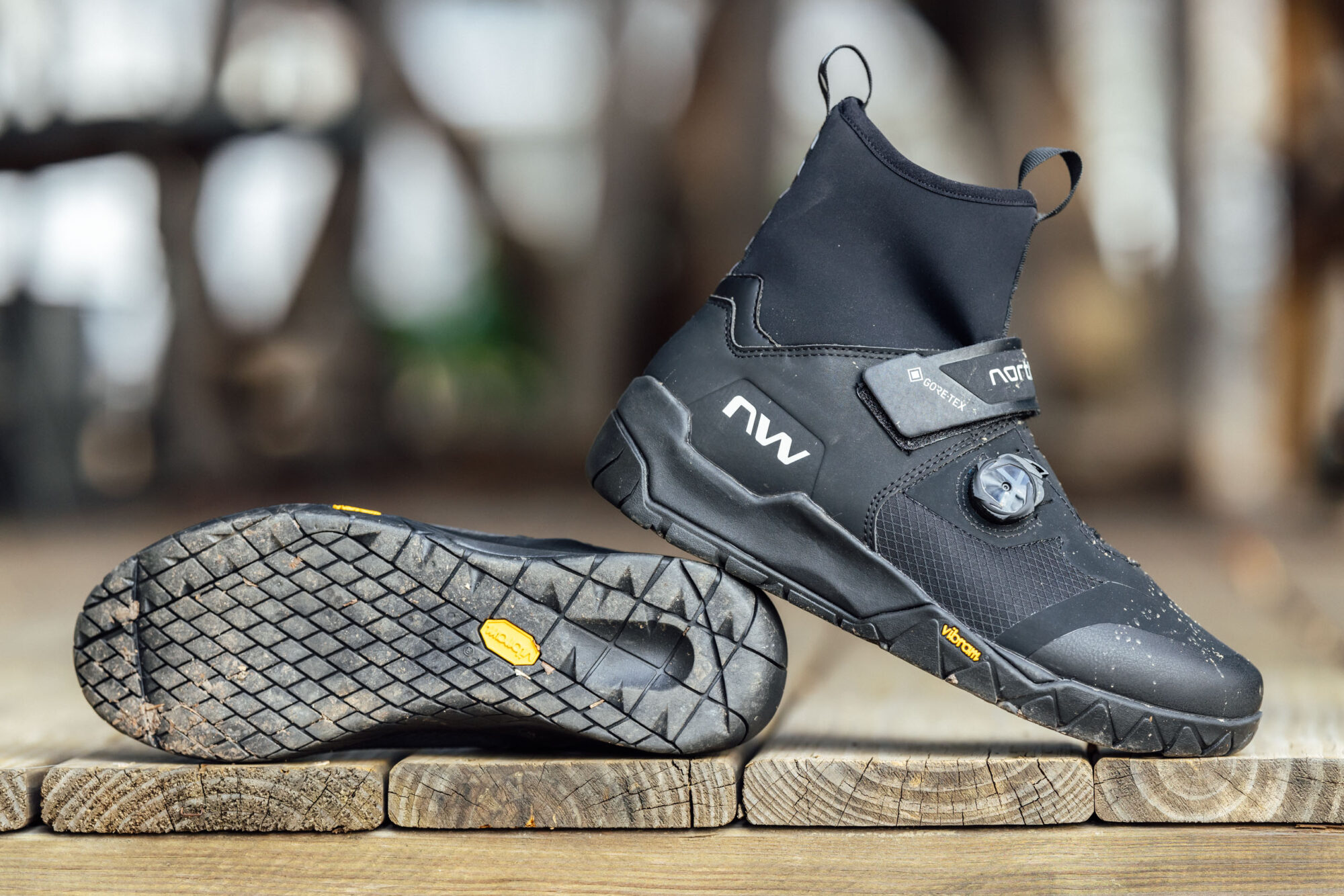
The Multicross was pretty comfortable from the start. The SLW3 dial applies pressure at the mid-foot, and the strap pulls the foot back at the upper arch; the two seemed to do a good job evening out pressure and locking in my feet. I didn’t have any pinch points or lack of a secure fit in any particular place. The SLW dial works as you’d expect with a ratcheting tension system, although there’s a button that you press to loosen it instead of rotating the dial or pulling it outward like you would with a BOA dial. The extended ankle gaiter is also a nice touch, and the fore and aft loops make getting them on and off pretty easy.
They’re fairly stiff shoes, but still comfortable and generally feel smaller and far less cumbersome than they appear. I was immediately impressed with how they feel on the pedals. The fit and profile still allow you to maneuver and finesse the bike, and the pedal grip is excellent. They have a slight concave sole profile that seemed to work very will with both my OneUp pedals and Wolf Tooth Waveforms. They’re also okay to walk in and have solid grip on rocks or dry roots. However, they don’t have great traction when hike-a-biking in leaves or on wet mud due to the lack of any significant lugs.
As for cold-weather performance, I think the Multicross are some of the warmest on this list. They kept my feet cozy in sub-freezing temperatures, and I’d be comfortable taking them out on big rides down to maybe 25 or 30°F (-1°C). They’re the most expensive shoes in this list, but if you’re looking for a solid winter shoe for mountain biking, with a preference for pedal grip and warmth, they might be a worthy investment. Like several of these newer shoes, I haven’t tested them for long-term durability, but I’ll be sure to report back. My only worry would be the longevity of the fabric loops used to secure the SLW3 dial cable.
Fit and sizing: The Northwave Multicross GTX comes in 18 sizes from 37-47 with some half sizes. The size 42 fit me fairly well, although they do seem to have a relatively narrow toe box. That said, I wasn’t bothered by it after taking them on a couple of long rides.
Pros
- Excellent grip and feel on pedals
- Feel smaller and more like shoes than they appear
- Very warm, even in freezing temps
- BOA-style dial does a good job at applying even pressure and strap takes up slack at back of foot
Cons
- Relatively narrow toe box
- Okay to walk in, but not great traction when hike-a-biking in leaves or on wet mud; good on rocks
- Heavy
- Not too sure about cloth loops for BOA wire, but no problems so far
Five Ten Trailcross Gore-Tex
Made in China / 444 grams (per shoe, US 9/EU 43.3) / $220 at Adidas
First off, Five Ten’s Trailcross lineup is kind of like a microcosm of their entire bike shoe range—there are a lot of options among their several variations, a handful of which might be discontinued at any given moment. Plus, all of them have confusing names and acronyms. There are multiple model lines in the Trailcross range now. They all feature a rather sportive look, Five Ten’s Stealth Phantom rubber sole, and a semi-flexible shank that’s suitable for riding, hiking, and everything in between. They also use a lace-up closure with an elastic lace keeper. The Trailcross LT is the lightweight “warm climate” iteration, the Trailcross Mid Pro (shown here) is the burly “big mountain” shoe, and the XT is somewhere in between the two, which is “is designed with all countries and climates in mind.” They also have a GTX version—which is now called the Trailcross Gore-Tex—that has a Gore-Tex lining for wet and cold weather.
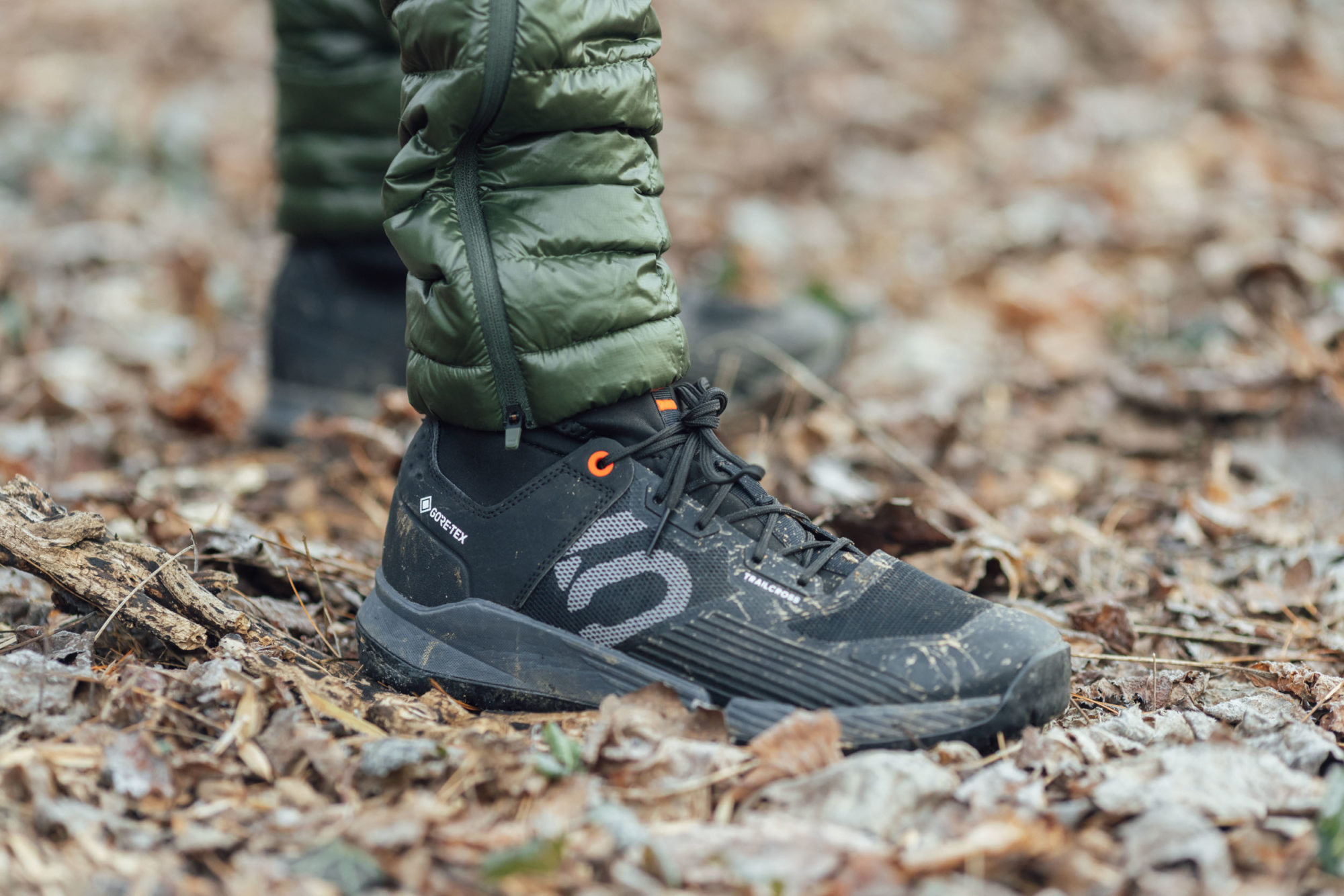
The Trailcross Mid Pro that we reviewed does not exist anymore. But you can read Cass’ full review here, which in summary, Cass said they might be his “favourite bikepacking shoes, simply because they’re so capable on the bike and comfortable off it.” The Trailcross Gore-Tex shares the same design and many of the same features and we’ve been testing them for a year.
As for chilly weather performance, the Trailcross Gore-Tex does a pretty good job in colder temps. I can ride in them down to about 45°F (7°C) and be fairly comfortable, although I wouldn’t call them winter shoe. Similar to the Mid Pro, they start getting a little warm in the upper 60s and I think that the mid 40s might be their limit, especially if you’re someone like me whose feet get cold easily.
Fit and sizing: The Trailcross Gore-Tex comes in 21 sizes from 4-15 that translate to women’s sizes 5-16. They run large for US sizing; I usually wear a 9.5 and the 9 was too big for me. The 43.3 in EU sizing seems more accurate as I usually wear 42.5.
Pros
- Very comfortable fit
- Very good pedal grip, although not as good as Freerider Pro series
- Durable construction
- Excellent for hiking with plenty of traction
Cons
- Expensive
- Not as warm as they could be
- Sizing is tricky
- No lace-keeper strap
Five Ten Impact Pro Mid
Made in China / 561 grams (per shoe, US 9 EU 43.6) / $180 at Adidas
As you can see in this roundup, Five Ten (Adidas) offers more flat-pedal-specific footwear for riding in cold weather than most brands. But that still only adds up to a couple of options. And their ever-changing shoe catalog is always a little confusing. The newest option in their range—and the latest shoe I’ve tried—is this revamped Impact Pro Mid, a shoe described as “a mid-height mountain bike shoe for long hauls in all weather.”
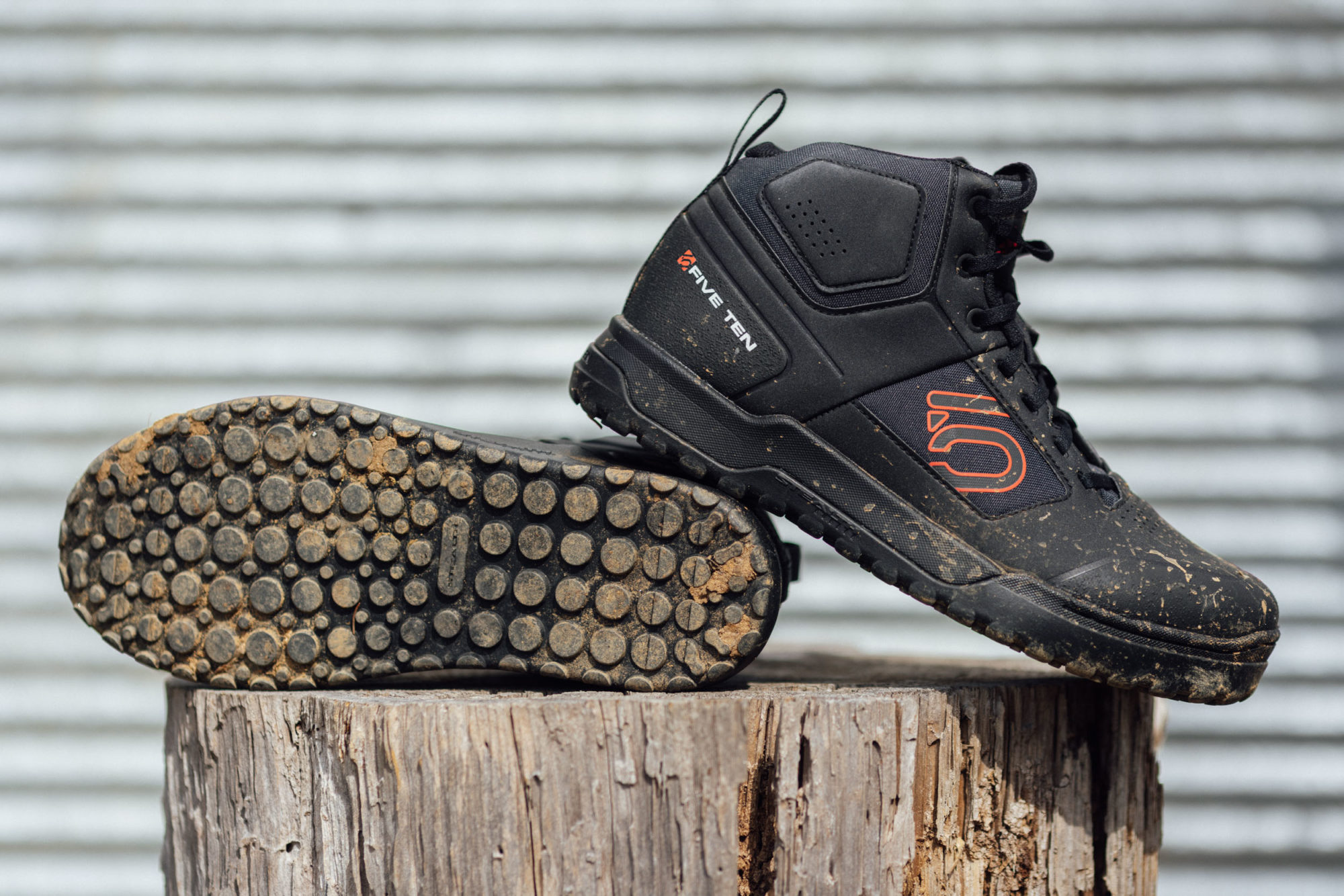
The Impact Pro Mid features a lace closure with a nice little elastic lace-keeper, a stout supportive upper, a reinforced toe box, and their own “D30” padding in the ankles for extra protection. The Impact Pro Mid also gets a Stealth S1 Dotty tread outsole like the Freerider Pro I’ve been impressed with. On the trail, the Stealth S1 rubber offers best-in-class grip, as expected, and they feel pretty good just walking around, too. They also have a far better hiking tread for steep scrambles than the EPS. There are deeper lugs at the toe and heel that have a squared-off pattern for traction, which seems like a great improvement over the flat sole of the EPS. They also feel much stiffer, and I’m hoping they have the same level of durability as the sole of the Freerider Pro.
Five Ten makes no claims about insulation in these shoes, unlike the Freerider EPS (more on that below), which contains Primaloft. However, I think they may be warmer than the EPS. I’ve only had them in my possession for three weeks at this point, but I managed to wear them on a couple of rides in temperatures in the 40s. No sign of cold feet, whatsoever.
Part of their proficiency in colder weather may be the general bulk of the shoe. Weighing in at 561 grams, these things are burly. I was worried they were a little too chunky, but on the trail, they didn’t feel overly big or bulky. They’re certainly more noticeable than the 350 gram Freerider Pro, but I think they have a lot of potential as a backcountry mountain expedition bike shoe. If anyone else has longer-term experience with them, please drop us a line in the conversation section.
Fit and sizing: Impact Pro Mid is available in 17 sizes from 6-15. Like other Five Tens, there are some weird numbers to navigate. In short, they run large for US sizing; I usually wear a 9.5 and the 9 fits me in this shoe. However, they’re a 43.6 in EU sizing and I usually wear 42.5.
Pros
- Very warm in temps hovering around 40°F (4°C)
- Great pedal grip with Dotty Rubber
- One of the few available with lace-up design
- Offers a lot of protection
Cons
- Very heavy
- Somewhat bulky compared to others
- Limited sizing; questionable availability
Ion Scrub Select
Made in Vietnam / 473 grams (per shoe, US 10 EU 43) / $190 at Ion
There are already two write-ups about the Ion Scrub Select on this site: one in my seven-shoe roundup from last summer and one in our Editor’s Dozen favorites list from the end of the year. Suffice to say, it’s become one of my go-to flat pedal shoes, particularly on long rides in the shoulder season. I won’t go into a ton of detail since I already reviewed them in the roundup, but in summary, their Ortholite EcoPlush insole and medium-stiff shank make them extremely comfortable on long rides. They also have outstanding pedal grip and have proven to be very durable.
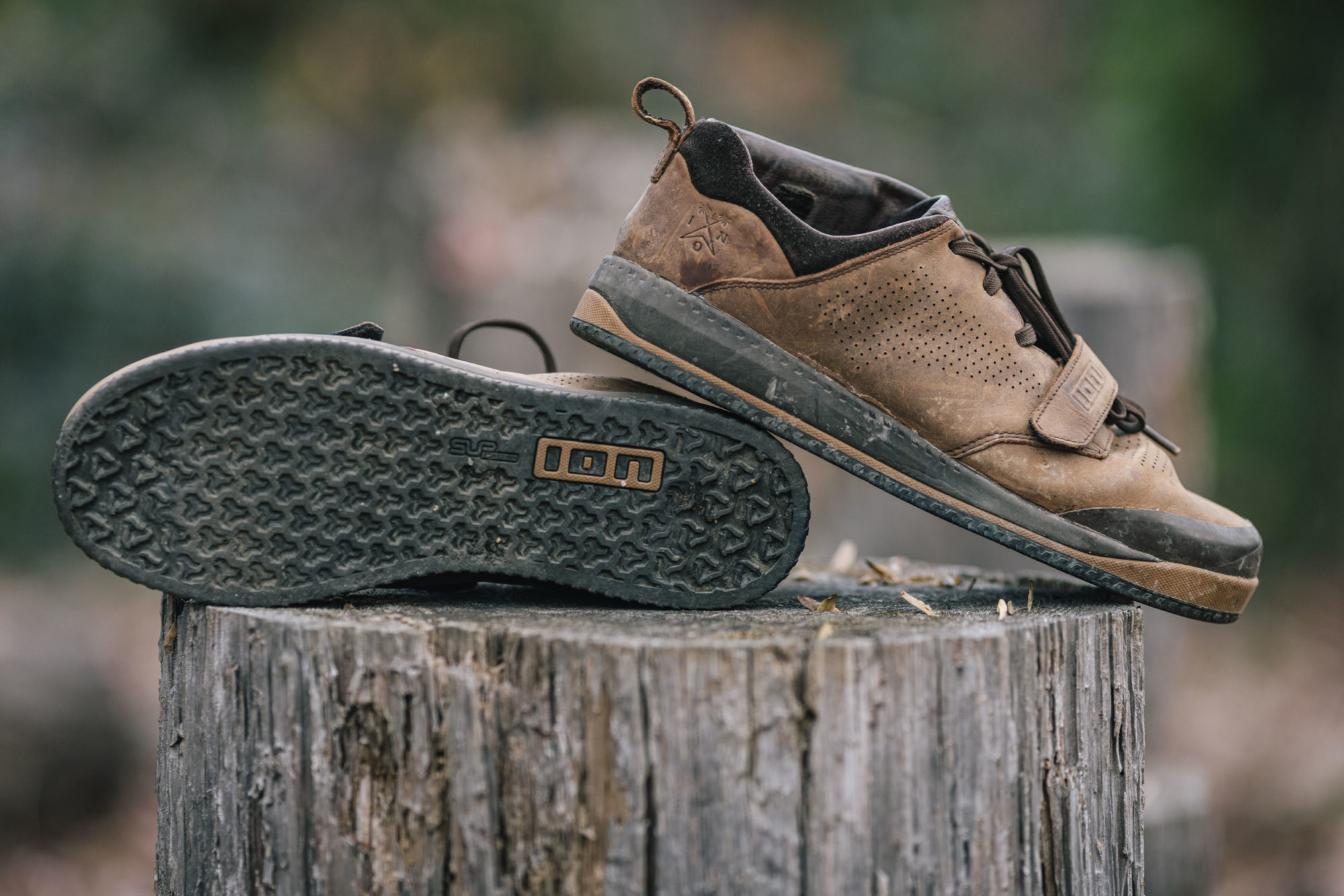
They’re also very well made with a double-stitched, four-piece construction, a rubber protective toe cap, and a fine-grain padded leather mid-top inner that offers additional padding and protection, particularly on the higher ankle side. They’re not waterproof, by any means, but they offer a little more insulation than most. That’s owed to the fact that their upper is made of real leather. I’ve ridden them in temperatures down in the low 40s (°F) and they do a surprisingly decent job when coupled with thick wool socks. I’d say their sweet spot is 50-60°F weather, however. They aren’t winter shoes.
Lastly, as I’ve mentioned before, that leather aesthetic doesn’t scream “cycling shoe”. Aside from the velcro lace-keeper strap, they’re fairly attractive and modest shoes that you can kick around in almost anywhere. Find the more detailed write-up over in the roundup.
Fit and sizing: Ion Scrub Selects come in 12 sizes from 36-47 with no half sizes. Ion’s shoes run a little small; I usually wear a US 9.5, but their 10 fit perfectly.
Pros
- Very comfortable on long rides
- Outstanding pedal grip
- Durable leather design
- Nice aesthetic compared to other flat shoes
Cons
- Relatively heavy
- Kind of expensive for non-Goretex shoe
- Limited sizing
Five Ten Freerider Eps Mid (RIP)
$150 / Made in China / 540 grams (per shoe, US 9.5 EU 43.3)
The Five Ten Freerider EPS Mid is a cold-weather take on Five Ten’s classic skate-style flat MTB shoe. Winterizing features include a heat-reflective footbed, a coated, weather-resistant leather upper with minimal seams, and PrimaLoft insulation strategically placed throughout the shoe.
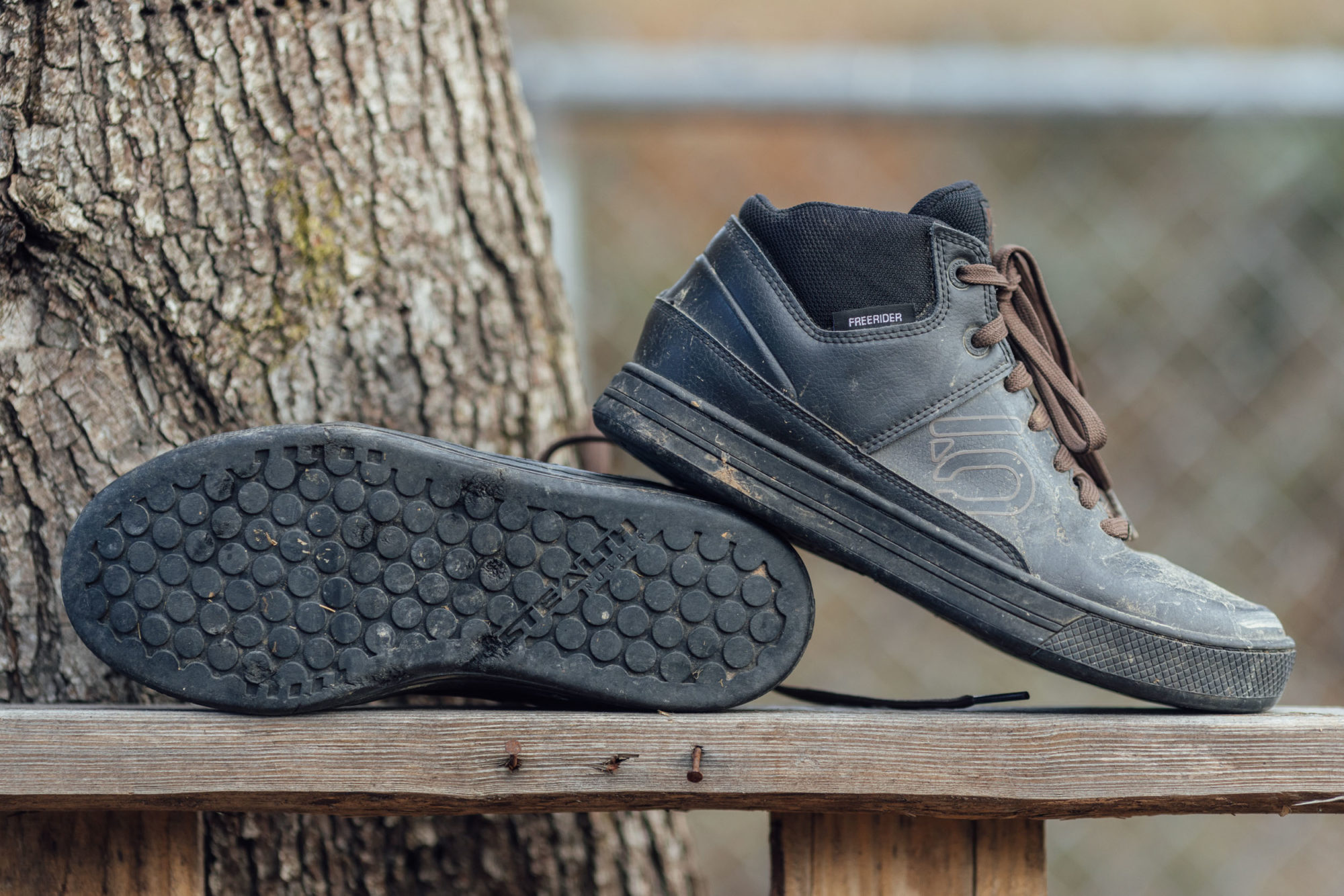
Both Cass and I tested them to no end; the ones in the photos below are his and have traveled across Peru and Ecuador, shrugging off snow and rainfall in their way. Mine are just about as worse for wear after three seasons of regular-to-intermittent use. In short, the EPS Mid have been a great winter riding shoe, for the most part. I’ve ridden in them in near-freezing temperatures and they’ve kept my feet toasty, although I think the heat-reflective footbed falls a little flat. I’ve found them to be warmer with a composite pedal. Fortunately, they don’t seem to be overly hot when temps are in the 50s, so I’m more inclined to wear them when temps are in the 40s and 50s.
Like the classic Freerider, I find the Freerider EPS Mid to be a super comfy shoe, and one of my favorites for trail riding because of the fit—and illustrious pedal grip, of course. The softer, tackier Stealth S1 sole compound is the best in the business in that regard. However, there’s a significant difference between the sole on the Freerider and the one used in the Pro versions (Impact Pro and Freerider Pro). The Pro versions are far more durable, which I think is due in part to the stiffer compression-molded midsole. The Freerider and Freerider EPS tend to get a flimsy sole after a good bit of use. It’s like they’re tenderized after a season or so of riding and get very soft and flexible. After about three seasons of shoulder season and winter riding, mine are nearly kaput.
Fit: The US sizing is accurate (I wear a 9.5), but the EU sizing seems off as these are 43.3 and I usually wear a 42.5.
PEdALED Mido Boots (RIP)
$305 / Made in Italy / 428 grams (per shoe, EU 40)
I haven’t personally tried PEdALED’s Italian-made Mido boots, but not because I didn’t want to. I admired Joe’s in Kyrgyzstan and later got a pair for review. However, they were a half-size too large. Fortunately, Cass wears shoes a half size up from me, so I was able to send them to him for a full-on test.
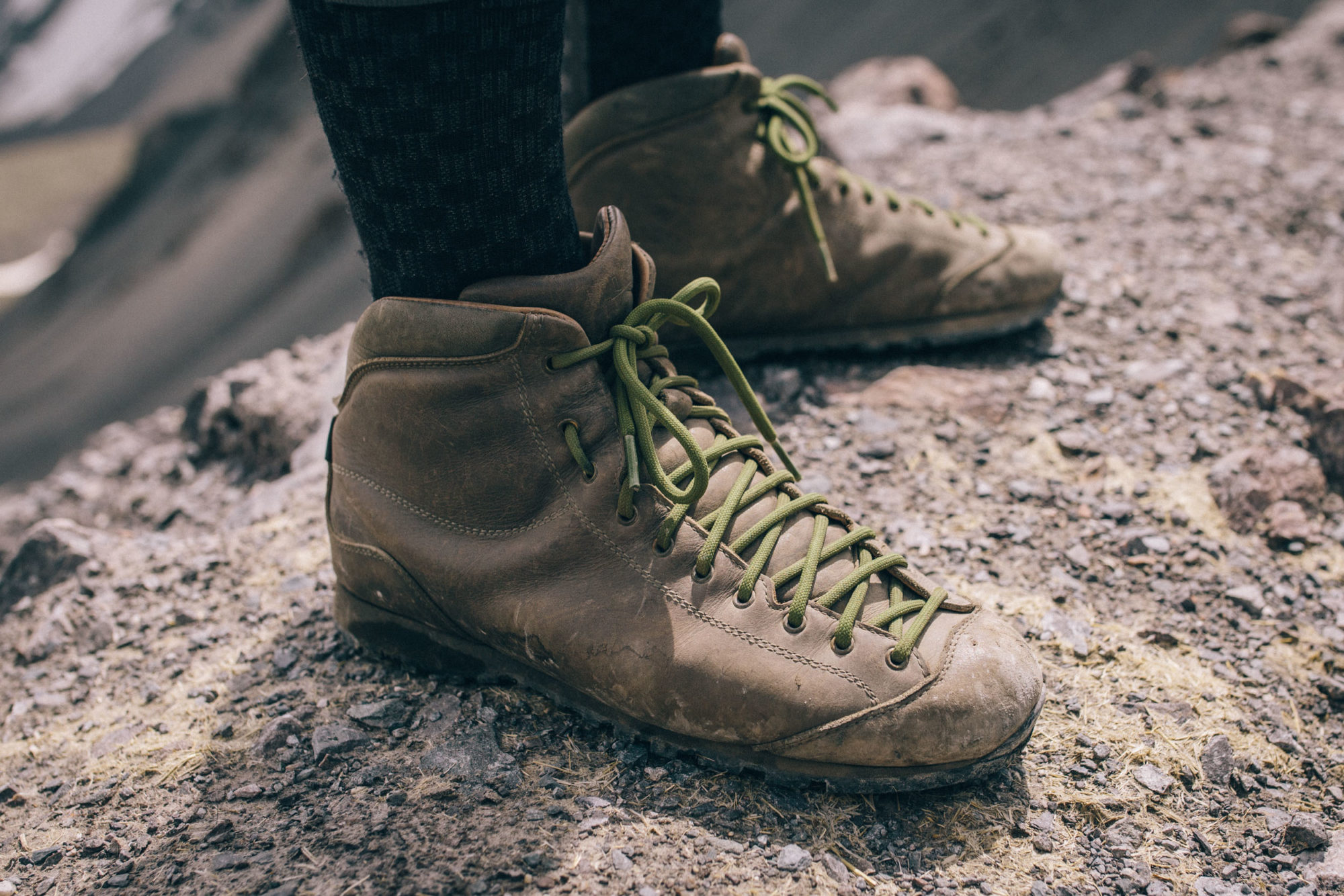
I won’t go into any specifics, as you can read that in Cass’ write-up—complete with a second opinion from Joe. From the outset, there’s a lot to like about these boots, however. They have a low-profile sole that isn’t too bulky but is still effective on surfaces like the chunky scree that we encountered in Kyrgyzstan. They’re also incredibly handsome, with a climbing aesthetic and full-laced design. It’s also proven to be supremely durable, according to both testers, and performs well on the bike with decently sticky rubber and a simple tread pattern.
Lastly, the full-leather upper makes it capable in temps that mountains climates can dish out. When I asked Joe about the temperature range that the Mido could handle, he replied, “I don’t regard them as a real cold-weather option, but they’re surprisingly comfortable when it gets warm. So, for me, I’d say 45F+. Probably some people would find just the fact that they’re boots and leather kinda oppressive when it really gets up there, even though I don’t. So, 45-80F is a reasonable bet.”
Fit: The Mido has a narrow last and generally run large; I typically wear a 42.5 and the 43 was too big, even with thick socks.
Five Ten Guide Tennies (RIP)
$160 / Made in China / 448 grams (per shoe, US 9.5 EU 42.5)
Five Ten Guide Tennies are something of a classic at this point. In my eyes, at least. I have one pair that has over 4,000 miles on them, and two more that I’m preserving for some hypothetical future trip, including the pair of Mid-tops shown here, which went on our trip in Kyrgyzstan back in 2016. Unfortunately, the Mids were discontinued. Even so, I wanted to include them here in hopes that Adidas will bring them back.
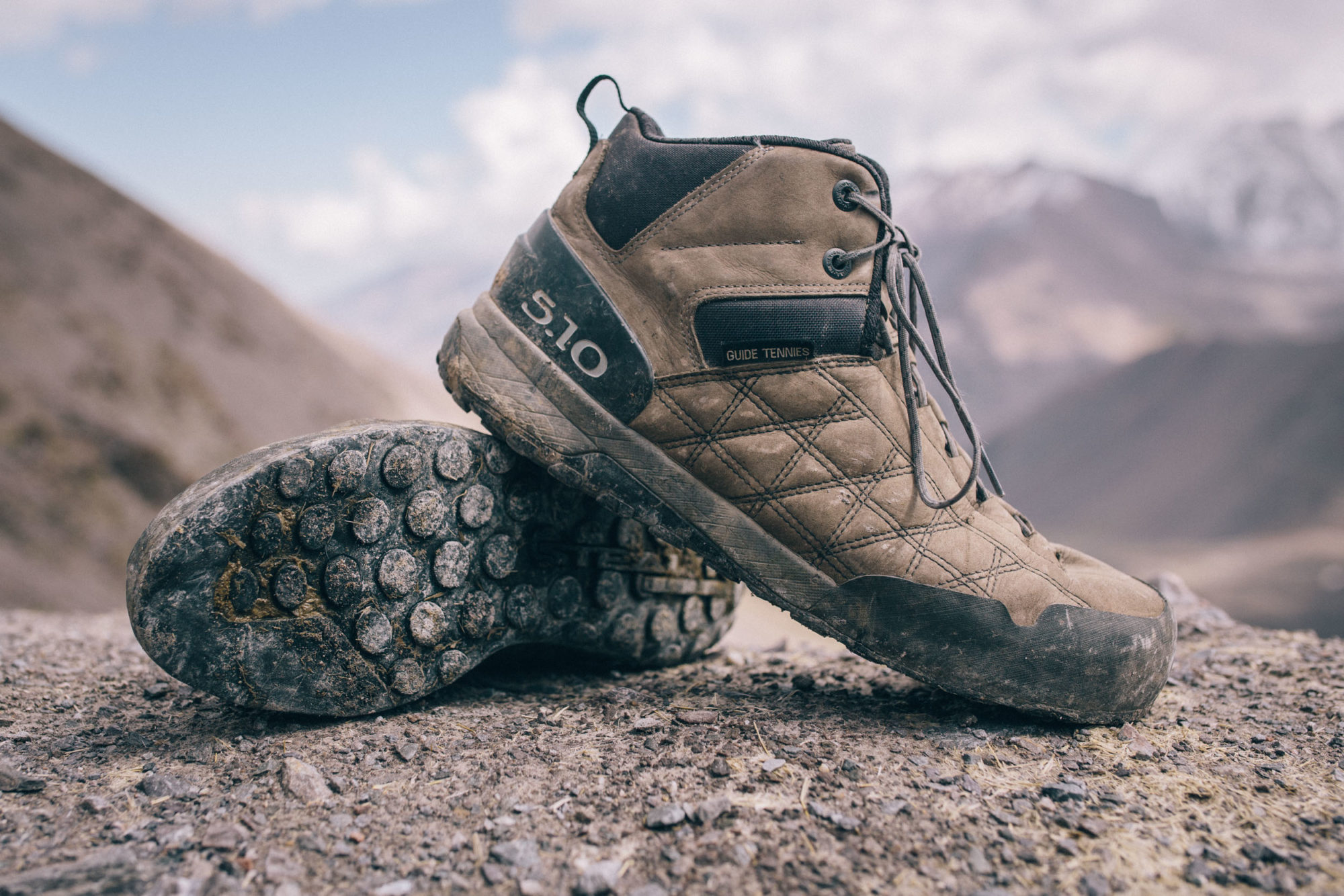
While the Guide Tennie is really an approach shoe, when paired with aggressive flat pedals, their dotty rubber sole has excellent grip that rivals some of Five Ten’s bike-specific shoes. Even though it’s a harder rubber compound, I think it’s just as good as many of the Freerider range with the right pedals. Adding to that, they’re unbelievably durable—the 4,000-mile review on one pair proved that—very comfortable, and perform pretty well off the bike.
The taller Mids shown here make for a little more of a burly riding boot, one that I thought was perfect for a ride on the Tian Shan Traverse. They’re also worth having in this list as I think they’re a little warmer than most bike shoes—and in hopes that Adidas/Five Ten will reintroduce them into their product catalog. We had temperatures that ranged from the 20s on up to 90+ on that trip, and while I can’t say I didn’t have numb toes at some point, they handled the cold pretty well and felt good in most other temperatures, too.
Fit: The fit was spot on with the Guide Tennies; US 9.5/EU 42.5 fit perfectly.
Tips for Keeping Your Feet Warm (and Dry)
Here are a few tips for keeping your feet warm that we’ve gathered from bikepacking in mountain conditions over the years. If you have others, please let us know in the conversation below.
Wool socks
For the same reasons we like it as an upper base layer—insulating properties even when wet, odor control, and wick dry properties—merino wool makes a great material for socks. Defeet Woolie Boolies are one of our favorites. Patagonia’s thick wool socks are nice too.
Silk liner socks
Thin silk sock liners are another great option. WinterSilks is unfortunately no longer in business, but there are comparable products available from other manufacturers. Look for options with a silk and wool fabric blend and a super-thin construction so it doesn’t add bulk.
Gore-tex socks
Although sometimes disputed, we’ve found Gore-tex socks to be invaluable. They can act as an insulating layer between your socks and wet shoes. If the depth of the river crossing is less than the height of your Gore-tex socks, charge through. When wearing your shoes, you can tip-toe over submerged rocks and not have to think about it or slow down. If the depth of the crossing is higher than the sock, one possibility is taking off all of your socks, putting your shoes back on, crossing, and then quickly putting on your (still dry) wool socks with the Gore-tex socks over them. This will keep them relatively dry from the wet shoes. We like this approach for rocky or rough river bottoms. As an alternative, plastic doggy-doo bags (or grocery plastic bags) can do the trick in a pinch. The model we have is no longer made, but Gore has some similar Shield Socks on offer for $50.
Tin foil Footbed Liner
Although we’ve never tried it, some folks recommend tracing your removable footbed on tinfoil, and adding that as a layer underneath it for added reflective heat insulation.
Toe and Shoe Covers
Obviously, there are a lot of toe and shoe covers out for clipless pedals, but we’re not aware of any for flat pedal shoes. If anyone has a recommendation, please feel free to share them.
Recommended Options
Unfortunately, this is a pretty short list with just six options—one of which is discontinued—so we published this in part to get recommendations from readers, as there must be other options out there. Perhaps they’re in the form of a good approach boot or just other bike options that we haven’t heard of. If you have a pair of cold-weather flat shoes you’d recommend, please let us know in the conversation below.
Related Content
Make sure to dig into these related articles for more info...
Please keep the conversation civil, constructive, and inclusive, or your comment will be removed.







